Kristine Hughes's Blog, page 158
February 21, 2011
The London Post Office 1850 - Part One
In this series, we turn to the words of Mr. Charles Dickens which appeared in the March 30, 1850 edition of the publication he edited, Household Words. The following article is chock full of details about how the Post Office operated in Victorian London and also about the mail and other items it processed on a daily basis.
The piece follows the progress of two gentlemen who make a visit to the Post Office -
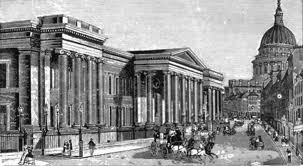 Great National Post-Office in St. Martin's-le-Grand
Great National Post-Office in St. Martin's-le-Grand
Most people are aware that the Great National Post-office in St. Martin's-le-Grand is divided into halves by a passage, whose sides are perforated with what is called the " Window Department." Here huge slits gape for letters, whole sashes yawn for newspapers, or wooden panes open for clerks to frame their large faces, like giant visages in the slides of a Magic Lantern; and to answer inquiries, or receive unstamped paid letters. The southern side is devoted to the London District Post, and the northern to what still continues to be called the "Inland Department," although foreign, colonial, and other outlandish correspondence now passes through it. It was with the London District Branch that the two gentlemen first appeared to have business.
Having been led through a maze of offices and passages more or less dark, they found themselves—like knights-errant in a fairy tale—" in an enormous hall, illumined by myriads of lights." Without being exactly transformed into statues, or stricken fast asleep, the occupants of this hall (whose name was Legion) appeared to be in an enchanted state of idleness. Among a wilderness of long tables, and of desks not unlike those on which buttermen perform their active parts of legerdemain in making " pats"—only these desks were covered with black cloth—they were reading books, talking together, wandering about, lying down, or drinking coffee—apparently quite unused to doing any work, and not at all expectant of ever having anything to do, but die.
In a few minutes, and without any preparation, a great stir began at one end of this hall, and a long train of private performers, in the highest state of excitement, poured in, getting up, on an immense scale, the first scene in the " Miller and his Men." Each had a sack on his back; each bent under its weight; and the bare sight of these sacks, as if by magic, changed all the readers, all the talkers, all the wanderers, all the liers-down, all the coffee-drinkers, into a colony of human ants.
For the sacks were great sheepskin bags of letters tumbling in from the receiving-houses. Anon they looked like whole flocks suddenly struck all of a heap, ready for slaughter; for a ruthless individual stood at a table, with sleeves tucked up and knife in hand, who rapidly cut their throats, dived into their insides, abstracted their contents, and finally skinned them. "For every letter we leave behind," said the bagopener, in answer to an inquiry, " we are fined half-a-crown. That's why we turn them inside out."
The mysterious visitors closely scrutinised the letters that were disgorged. These were from all parts of London to all parts of London and to the provinces and to the far-off quarters of the globe. An acute postman might guess the broad tenor of their contents by their covers:—business letters are in big envelopes, official letters in long ones, and lawyers' letters in none at all; the tinted and lace-bordered mean Valentines, the black-bordered tell of grief, and the radiant with white enamel announce marriage. When the despatch of the Fleet-street receiving-house appeared the visitors tracked it, and the operations of the clerk who separated the three bundles of which it consisted were closely followed. With the prying curiosity which now only began to show itself, one of the intruders took a copy of the bill which accompanied the letters. It set forth in three lines that there were so many " Stamped," so many " Prepaid," and so many " Unpaid."
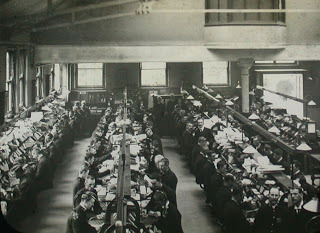
The clerk counted the stamped letters like lightning, and a flash of red gleaming past showed the inquirers that one of their epistles was safe. Suddenly the motion was stopped; the official had instinctively detected that one letter was insufficiently adorned with the Queen's profile, and he weighed and taxed it double in a twinkling. Having proved the number of stamped letters to be exactly as per account rendered, he went on checking off the prepaid, turning up the sender's green missive in the process. He then dealt with the unpaid, amongst which the lookers-on perceived their yellow one. The cash column was computed and cast in a single thought, and a short-hand mark, signifying " quite correct," dismissed the Fleet-street bill upon a file, for the leisurely scrutiny of the Receiver-General's office. All the other letters, and all the other bills of all the other receiving-houses, were going through the same routine at all the other tables; and these performances are repeated ten times in every day, all the year round, Sundays excepted.
" You perceived," said one of the two friends, "that in the rapid process of counting our stamped letter gleamed past like a meteor, whilst our money-paid and unpaid epistles remained long enough under observation for a careful reading of the superscriptions."
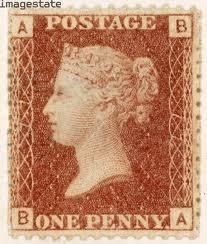
"That delay," said an intelligent official, "is occasioned because the latter are unstamped. Such letters cause a great complication of trouble, wholly avoided by the use of Queen's heads. Every officer through whose hands they pass—from the receiving-house-keeper to the carriers who deliver them at their destinations—has to give and take a cash account of each. If the public would put stamps on all letters, it would save us, and therefore itself, some thousands a year."
" What are the proportions of the stamped to the prepaid and unpaid letters which pass through all the post-offices during the year?"
" We can tell within a very near approximation to correctness: 337,500,000 passed through the post-offices of the United Kingdom during last year, and to every 100 of them about 50 had stamps; 46 were prepaid with pennies; and only 4 were committed to the box unpaid."
While one of the visitors was receiving this information, the other had followed his variegated letters to the next process; which was that of stamping on the sealed face, in red ink, the date and hour of despatch. The letters are ranged in a long row, like a pack of cards thrown across a table, and so fast does the stamper's hand move, that he can mark 6000 in an hour. While defacing the Queen's heads on the other side, he counts as he thumps, till he enumerates fifty, when he dodges his stamp on one side to put his black mark on a piece of plain paper. All these memoranda are afterwards collected by the president, who reckoning fifty letters to every black mark, gets a near approximation to the number that have passed through the office.
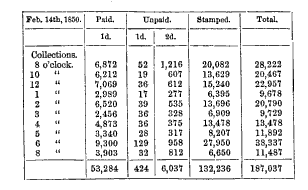
Part Two Coming Soon!
The piece follows the progress of two gentlemen who make a visit to the Post Office -
 Great National Post-Office in St. Martin's-le-Grand
Great National Post-Office in St. Martin's-le-Grand Most people are aware that the Great National Post-office in St. Martin's-le-Grand is divided into halves by a passage, whose sides are perforated with what is called the " Window Department." Here huge slits gape for letters, whole sashes yawn for newspapers, or wooden panes open for clerks to frame their large faces, like giant visages in the slides of a Magic Lantern; and to answer inquiries, or receive unstamped paid letters. The southern side is devoted to the London District Post, and the northern to what still continues to be called the "Inland Department," although foreign, colonial, and other outlandish correspondence now passes through it. It was with the London District Branch that the two gentlemen first appeared to have business.
Having been led through a maze of offices and passages more or less dark, they found themselves—like knights-errant in a fairy tale—" in an enormous hall, illumined by myriads of lights." Without being exactly transformed into statues, or stricken fast asleep, the occupants of this hall (whose name was Legion) appeared to be in an enchanted state of idleness. Among a wilderness of long tables, and of desks not unlike those on which buttermen perform their active parts of legerdemain in making " pats"—only these desks were covered with black cloth—they were reading books, talking together, wandering about, lying down, or drinking coffee—apparently quite unused to doing any work, and not at all expectant of ever having anything to do, but die.
In a few minutes, and without any preparation, a great stir began at one end of this hall, and a long train of private performers, in the highest state of excitement, poured in, getting up, on an immense scale, the first scene in the " Miller and his Men." Each had a sack on his back; each bent under its weight; and the bare sight of these sacks, as if by magic, changed all the readers, all the talkers, all the wanderers, all the liers-down, all the coffee-drinkers, into a colony of human ants.
For the sacks were great sheepskin bags of letters tumbling in from the receiving-houses. Anon they looked like whole flocks suddenly struck all of a heap, ready for slaughter; for a ruthless individual stood at a table, with sleeves tucked up and knife in hand, who rapidly cut their throats, dived into their insides, abstracted their contents, and finally skinned them. "For every letter we leave behind," said the bagopener, in answer to an inquiry, " we are fined half-a-crown. That's why we turn them inside out."
The mysterious visitors closely scrutinised the letters that were disgorged. These were from all parts of London to all parts of London and to the provinces and to the far-off quarters of the globe. An acute postman might guess the broad tenor of their contents by their covers:—business letters are in big envelopes, official letters in long ones, and lawyers' letters in none at all; the tinted and lace-bordered mean Valentines, the black-bordered tell of grief, and the radiant with white enamel announce marriage. When the despatch of the Fleet-street receiving-house appeared the visitors tracked it, and the operations of the clerk who separated the three bundles of which it consisted were closely followed. With the prying curiosity which now only began to show itself, one of the intruders took a copy of the bill which accompanied the letters. It set forth in three lines that there were so many " Stamped," so many " Prepaid," and so many " Unpaid."

The clerk counted the stamped letters like lightning, and a flash of red gleaming past showed the inquirers that one of their epistles was safe. Suddenly the motion was stopped; the official had instinctively detected that one letter was insufficiently adorned with the Queen's profile, and he weighed and taxed it double in a twinkling. Having proved the number of stamped letters to be exactly as per account rendered, he went on checking off the prepaid, turning up the sender's green missive in the process. He then dealt with the unpaid, amongst which the lookers-on perceived their yellow one. The cash column was computed and cast in a single thought, and a short-hand mark, signifying " quite correct," dismissed the Fleet-street bill upon a file, for the leisurely scrutiny of the Receiver-General's office. All the other letters, and all the other bills of all the other receiving-houses, were going through the same routine at all the other tables; and these performances are repeated ten times in every day, all the year round, Sundays excepted.
" You perceived," said one of the two friends, "that in the rapid process of counting our stamped letter gleamed past like a meteor, whilst our money-paid and unpaid epistles remained long enough under observation for a careful reading of the superscriptions."

"That delay," said an intelligent official, "is occasioned because the latter are unstamped. Such letters cause a great complication of trouble, wholly avoided by the use of Queen's heads. Every officer through whose hands they pass—from the receiving-house-keeper to the carriers who deliver them at their destinations—has to give and take a cash account of each. If the public would put stamps on all letters, it would save us, and therefore itself, some thousands a year."
" What are the proportions of the stamped to the prepaid and unpaid letters which pass through all the post-offices during the year?"
" We can tell within a very near approximation to correctness: 337,500,000 passed through the post-offices of the United Kingdom during last year, and to every 100 of them about 50 had stamps; 46 were prepaid with pennies; and only 4 were committed to the box unpaid."
While one of the visitors was receiving this information, the other had followed his variegated letters to the next process; which was that of stamping on the sealed face, in red ink, the date and hour of despatch. The letters are ranged in a long row, like a pack of cards thrown across a table, and so fast does the stamper's hand move, that he can mark 6000 in an hour. While defacing the Queen's heads on the other side, he counts as he thumps, till he enumerates fifty, when he dodges his stamp on one side to put his black mark on a piece of plain paper. All these memoranda are afterwards collected by the president, who reckoning fifty letters to every black mark, gets a near approximation to the number that have passed through the office.

Part Two Coming Soon!
Published on February 21, 2011 01:38
February 20, 2011
Guest Blogger Judith Laik Carves Coade-Stone
 Our guest blogger today is Judith Laik, who has traveled with us in England and loves all things Regency. She is the author of two Regency romances with Kensington Publishing Corp., and other works of fiction. The second edition of her co-authored book of quotations, Around the Circle Gently, has been released. Judith is a columnist for 1st Turning Point . She is currently working on a Regency historical and other projects.
Our guest blogger today is Judith Laik, who has traveled with us in England and loves all things Regency. She is the author of two Regency romances with Kensington Publishing Corp., and other works of fiction. The second edition of her co-authored book of quotations, Around the Circle Gently, has been released. Judith is a columnist for 1st Turning Point . She is currently working on a Regency historical and other projects.She lives on a small farm in Washington state with her husband, daughter, and various animals. Visit her website here. Written sections of this post: ©Judith Laik.
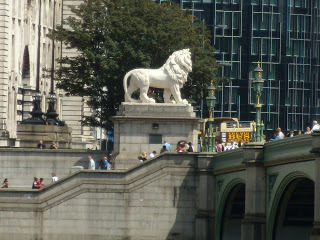 Coade-stone lion at Westminster Bridge, London;
Coade-stone lion at Westminster Bridge, London;Near location of early 19th c. Coade Stone manufactory
First, thanks to Vicky and Kristine for posting my article on their blog, and the credit for the amazing photos that accompany the article also goes to them. Kristine also found some additional information about the Coade Stone company that adds a lot to what I had found.
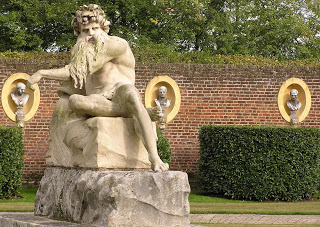 Father Thames in Coade-stone, Ham House Garden
Father Thames in Coade-stone, Ham House GardenSculptor: John Bacon Eleanor Coade combined scientific and business success. She ran the Coade Stone business for twenty-five years after her husband died until it was taken over by the daughter, also named Eleanor (or Elinor in some sources). Or his business might have been unrelated to the construction material and it was the daughter who became involved in the artificial stone business and ran it.
Researching the two Eleanors is an example of a researcher's nightmare. Some of the sources have the two women confused. But the researcher's nightmare is the fiction writer's delight, because after a serious attempt to run down the truth, someone writing fiction can choose the preferred version, fictionalize a bit more, and have fun with it.
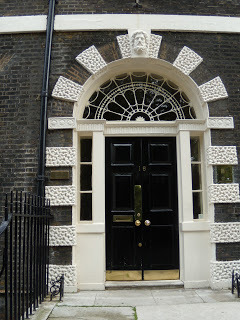 Entranceways in Coade-stone in
Entranceways in Coade-stone in Bedford Square
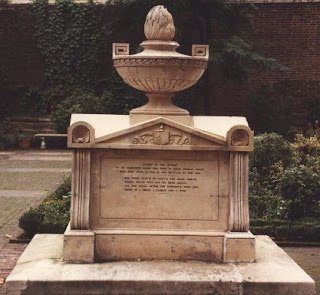 Tomb of Captain Bligh in Coade-stone
Tomb of Captain Bligh in Coade-stoneGarden Museum, LondonCoade stone was a spectacularly durable cement-like product (actually a ceramic material that is created by subjecting it to considerable heat in a kiln) building material which still looks new even today. It was very popular during the first half of the 19th century, and used by many of the noted architects and builders of the period.
The following account is from Some Account of London by Thomas Pennant (1813) - In a street called Narrow Wallis Mrs. Coade's manufactory of artificial stone. Her repository consists of several very large rooms filled with every ornament which can be used in architecture. The statue, the vase, the urn, the rich chimneypiece, and, in a few words, every thing which could be produced out of natural stone or marble by the most elegant chissel, is here to be obtained at an easy rate. Proof has been made of its durable quality.
A look at the inner workings of the Coades business is provided in The History of Ceramic Art in Great Britain by Llewellynn Frederick William Jewitt (1878) -
Coades.—Coade's Artificial Stone Works, at Pedlar's Acre, King's Arms Stairs, Narrow Wall, Lambeth, opposite Whitehall Stairs or Ferry, were established about 1760 by Mrs. or the Misses Coade, under the name of "Coade's Lithodipyra, Terra Cotta, or Artificial Stone Manufactory." This material was intended to take the place of carved stone for vases, statues, and architectural enrichments. In 1769 the two Misses Coade took into partnership their cousin, a Mr. Sealy (the nephew of Mr. Coade), and by these the works ere carried on. In 1811 the firm was still "Coades & Sealy." At the death of Mr. Sealy, who survived the Misses Coade, a Mr. Croggan, who had for a long time been a clerk or manager attached to the business, became the proprietor of the works, which he continued for many years. He then disposed of the business to Messrs. Routledge, Greenwood, & Keene, who were succeeded by Messrs. Routledge and Lucas. These gentlemen, about 1840, dissolved partnership and sold off all their moulds, models, plant, etc, by auction, by Messrs. Rushworth and Jarvis, of Saville Row. Many of these moulds and models were bought by Mr. Blashfield and by other manufacturers, among whom was Mr. H. M. Blanchard of Blackfriars Road (which see), and who, being an apprentice with the Coades, and possessing many of their models, etc. claims to be their successor.
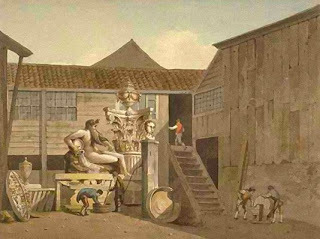 Coade and Sealey's Artificial Stone Factory, by Thomas Hosmer Shepherd The Coades are said to have come from Lyme Regis, in Dorsetshire, and probably it was for the purpose of turning their native clay to good account in London that induced them to establish this manufactory. Bacon, Flaxman, Banks, Rossi, and Panzetta, the sculptors, were employed to model for these works, and many of the old mansions and public buildings in London and in the country, as well as abroad—including the bas-relief in the pediment over the western portico of Greenwich Hospital, representing the death of Nelson, designed by Benjamin West, and modelled by Bacon and Panzetta; and the rood-screen of St. George's Chapel, Windsor; the statue of Britannia on the Nelson monument at Yarmouth, &c— were executed at these works. The works principally produced at Coades were capitals of columns, statues, vases, bassi-relievi, monuments, coats of arms, key-stones, angle rusticated blocks, balustrades, &c They were of durable quality and excellent manufacture.
Coade and Sealey's Artificial Stone Factory, by Thomas Hosmer Shepherd The Coades are said to have come from Lyme Regis, in Dorsetshire, and probably it was for the purpose of turning their native clay to good account in London that induced them to establish this manufactory. Bacon, Flaxman, Banks, Rossi, and Panzetta, the sculptors, were employed to model for these works, and many of the old mansions and public buildings in London and in the country, as well as abroad—including the bas-relief in the pediment over the western portico of Greenwich Hospital, representing the death of Nelson, designed by Benjamin West, and modelled by Bacon and Panzetta; and the rood-screen of St. George's Chapel, Windsor; the statue of Britannia on the Nelson monument at Yarmouth, &c— were executed at these works. The works principally produced at Coades were capitals of columns, statues, vases, bassi-relievi, monuments, coats of arms, key-stones, angle rusticated blocks, balustrades, &c They were of durable quality and excellent manufacture.Another person employed at Coades was William John Coffee, who afterwards attained some celebrity as a modeller at the Derby China Works, and as a terra cotta maker, for a short time, at Derby. I believe he was employed as a fire-man at Coades, and here, no doubt, being a clever fellow, picked up his knowledge of modelling and of mixing bodies. The following curious letter and "information," from the originals in my own possession, give some highly interesting particulars regarding Coades' and Sealy's manufactory in 1790 :—
"The information got from the fire-man that work'd at the Artificial Stone Manufactory, Lambeth:—There is three kilns, the largest is 9 feet diameter and about 10 feet high, the other two are sizes under; they have only three fire-holes to each, and they are about 14 inches in the clear. They make use of no saggers, but their kilns are all muffled about two inches thick, which was always done by this fire-man. They always was four days and four nights of fireing a kilns, and the moment the goods are fire'd up he always took and stop'd the kilns intirely colse from any air whatever without lowering the fires at all. He has been use to fire intirely with coal (which are call'd Hartley coals—they are not much unlike yours at Derby). He never made use of any thermometer, but depended intirely on his own knowledge. Tne composition shrinks about half an inch in a foot in the drying, and about the same in the firing. A great deal of the ornaments are 4 inches thick when fired, and he has fired figures 9 feet high. This man has had the intire management of building the kilns, setting and firing them for many years; his wages was one guinea per week, and for every night when he fired he had 2s. 6d. for the small kiln, 3.1. . . . "
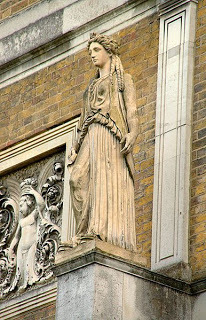 One of the four Coade stone caryatids that stand atop the
One of the four Coade stone caryatids that stand atop the columns of the east front of Pitzhanger ManorClick here for an interesting article about Coade stone and Mrs. Coade. Further articles can be found here and here. [image error]
Published on February 20, 2011 02:09
February 19, 2011
On The Shelf - Discovering New Authors - Part Four
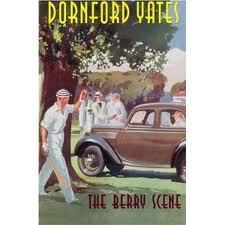 Dornford Yates, real name Cecil William Mercer, born in 1885 at Walmer, Kent, is the author of the comic Berry books. The main characters of the Berry Books are the Pleydell family who reside at 'White Ladies' in Hampshire, made up of Berry Pleydell, Daphne Pleydell, his wife (and cousin), Boy Pleydell (Daphne's brother and narrator of the books), Jonathan (Jonah) Mansel (cousin to all the above), Jill Mansel (Jonah's sister) and with occasional appearances by Boy's American fiancée (and later wife), Adèle. This is a group of privileged and pretty young things who excell at verbal barbs, comedic situations and much good humoured malice. Berry refers to Boy as "my brother-in-law, carefully kept from me before my marriage and by me ever since."
Dornford Yates, real name Cecil William Mercer, born in 1885 at Walmer, Kent, is the author of the comic Berry books. The main characters of the Berry Books are the Pleydell family who reside at 'White Ladies' in Hampshire, made up of Berry Pleydell, Daphne Pleydell, his wife (and cousin), Boy Pleydell (Daphne's brother and narrator of the books), Jonathan (Jonah) Mansel (cousin to all the above), Jill Mansel (Jonah's sister) and with occasional appearances by Boy's American fiancée (and later wife), Adèle. This is a group of privileged and pretty young things who excell at verbal barbs, comedic situations and much good humoured malice. Berry refers to Boy as "my brother-in-law, carefully kept from me before my marriage and by me ever since." The stories are anecdotal, and involve some sort of privileged problem – their Rolls-Royce is stolen, a hat is blown away in the wind, an offensive neighbour is rude about Nobby, their dog. The resolution often involves outrageous coincidence. No one works, although the male members of the family occasionally do "go up to Town" on some vague business related matters which are never fully explained, and pithy conversations abounds.
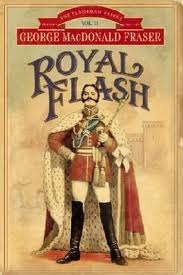 Created by author George MacDonald Fraser, Sir Harry Paget Flashman (VC, KCB and KCIE) (1822–1915) is the fictional hero of the Flashman series, first begun in 1969. As Wikipedia tells us: "Presented within the frame of the supposedly discovered historical Flashman Papers, the book begins with an explanatory note saying that the Flashman Papers were discovered in 1965 during a sale of household furniture Leicestershire. Flashman is a well known Victorian military hero (in Fraser's fictional England). The papers were supposedly written between 1900 and 1905. The subsequent publishing of these papers, of which Flashman is the first, contrasts the previously believed exploits of a (fictional) hero with his own more scandalous account, which shows the life of a cowardly bully. Flashman begins with his own account of expulsion from Rugby and ends with his fame as the "Hector of Afghanistan", detailing his life from 1839 to 1842 and his travels. It also contains a number of notes by the author, in the guise of a fictional editor, giving additional historical information on the events described. The history in these books is quite accurate; most of the people Flashman meets are real people." Flashman is in turn charming, brave, cowardly, a liar and a legend in his own mind, but you can't help but be amused by him.
Created by author George MacDonald Fraser, Sir Harry Paget Flashman (VC, KCB and KCIE) (1822–1915) is the fictional hero of the Flashman series, first begun in 1969. As Wikipedia tells us: "Presented within the frame of the supposedly discovered historical Flashman Papers, the book begins with an explanatory note saying that the Flashman Papers were discovered in 1965 during a sale of household furniture Leicestershire. Flashman is a well known Victorian military hero (in Fraser's fictional England). The papers were supposedly written between 1900 and 1905. The subsequent publishing of these papers, of which Flashman is the first, contrasts the previously believed exploits of a (fictional) hero with his own more scandalous account, which shows the life of a cowardly bully. Flashman begins with his own account of expulsion from Rugby and ends with his fame as the "Hector of Afghanistan", detailing his life from 1839 to 1842 and his travels. It also contains a number of notes by the author, in the guise of a fictional editor, giving additional historical information on the events described. The history in these books is quite accurate; most of the people Flashman meets are real people." Flashman is in turn charming, brave, cowardly, a liar and a legend in his own mind, but you can't help but be amused by him.  I've never cared for Alexander McCall Smith's Number One Ladies Detective Agency books, but I love the 44 Scotland Street and Corduroy Mansions series. The Corduroy Mansions books are set in a four-storey mansion that's been divided into flats in London's Pimlico section. The flats are occupied by an ensemble of cheerfully eccentric characters who are all too human and with whom the reader can readily relate. Smith handles the multi-faceted plots deftly and gives us readers to both love and loathe. Plot devices come in the form of situations with which most can identify. The third floor tenant, William French, a widower and wine merchant, is trying to get rid of his free-loading son Eddie, a young man who simply cannot take a hint. Playing on Eddie's dread of dogs, William gets one, in the form of Freddie de la Hay, who manages to dislodge Eddie, but who also sets the stage for further problems for William.
I've never cared for Alexander McCall Smith's Number One Ladies Detective Agency books, but I love the 44 Scotland Street and Corduroy Mansions series. The Corduroy Mansions books are set in a four-storey mansion that's been divided into flats in London's Pimlico section. The flats are occupied by an ensemble of cheerfully eccentric characters who are all too human and with whom the reader can readily relate. Smith handles the multi-faceted plots deftly and gives us readers to both love and loathe. Plot devices come in the form of situations with which most can identify. The third floor tenant, William French, a widower and wine merchant, is trying to get rid of his free-loading son Eddie, a young man who simply cannot take a hint. Playing on Eddie's dread of dogs, William gets one, in the form of Freddie de la Hay, who manages to dislodge Eddie, but who also sets the stage for further problems for William. 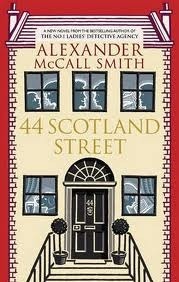 Set in Edinburgh, the 44 Scotland Street series focuses on yet another set of residents. As Publisher's Weekly said, the book, "drolly chronicles the lives of residents in an Edinburgh boarding house— it's episodic, amusing and peopled with characters both endearing and benignly problematic. Pat, 21, is on her second "gap year" (her first yearlong break from her studies was such a flop she refuses to discuss it), employed at a minor art gallery and newly settled at the eponymous address, where she admires vain flatmate Bruce and befriends neighbor Domenica. A low-level mystery develops about a possibly valuable painting that Pat discovers, proceeds to lose and then finds in the unlikely possession of Ian Rankin, whose bestselling mysteries celebrate the dark side of Edinburgh just as Smith's explore the (mostly) sunny side. The possibility of romance, the ongoing ups and downs of the large, well-drawn cast of characters, the intricate plot and the way Smith nimbly jumps from situation to situation and POV to POVworks beautifully in book form. No doubt Smith's fans will clamor for more about 44 Scotland Street, and given the author's celebrated productivity, he'll probably give them what they want."Really, the only problem with these books is deciding which dog is more delicious, Cyril with the gold tooth (44 Scotland Street) or Freddie de la Hay (Corduroy Mansions). You can visit the author's website here.
Set in Edinburgh, the 44 Scotland Street series focuses on yet another set of residents. As Publisher's Weekly said, the book, "drolly chronicles the lives of residents in an Edinburgh boarding house— it's episodic, amusing and peopled with characters both endearing and benignly problematic. Pat, 21, is on her second "gap year" (her first yearlong break from her studies was such a flop she refuses to discuss it), employed at a minor art gallery and newly settled at the eponymous address, where she admires vain flatmate Bruce and befriends neighbor Domenica. A low-level mystery develops about a possibly valuable painting that Pat discovers, proceeds to lose and then finds in the unlikely possession of Ian Rankin, whose bestselling mysteries celebrate the dark side of Edinburgh just as Smith's explore the (mostly) sunny side. The possibility of romance, the ongoing ups and downs of the large, well-drawn cast of characters, the intricate plot and the way Smith nimbly jumps from situation to situation and POV to POVworks beautifully in book form. No doubt Smith's fans will clamor for more about 44 Scotland Street, and given the author's celebrated productivity, he'll probably give them what they want."Really, the only problem with these books is deciding which dog is more delicious, Cyril with the gold tooth (44 Scotland Street) or Freddie de la Hay (Corduroy Mansions). You can visit the author's website here. Part Five Coming Soon!
Published on February 19, 2011 01:00
February 18, 2011
Do You Know About Gresham College?
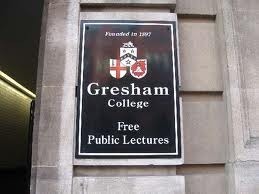
Gresham College has no students and does not teach courses, rather it is an educational institution of higher learning that exists to provide free public lectures, which have now been running for over 400 years. Gresham College was founded by Sir Thomas Gresham in 1597, son of Sir Richard Gresham who was Lord Mayor in 1537/38. Gresham College started long before there was a University of London.
Sir Thomas Gresham (1519-1579) stated in his will that Gresham College was to provide free public lectures in Divinity, Astronomy, Music, Geometry, Law, Physic and Rhetoric, endowed by revenue from the Royal Exchange, which he founded in 1570.
The Royal Society can trace its roots back to Gresham College and to 28 November 1660, when 12 of the members met at Gresham College after a lecture by Christopher Wren, the Gresham Professor of Astronomy, and decided to found 'a Colledge for the Promoting of Physico-Mathematicall Experimentall Learning'. This group included Wren himself, Robert Boyle, John Wilkins, Sir Robert Moray and William, Viscount Brouncker.
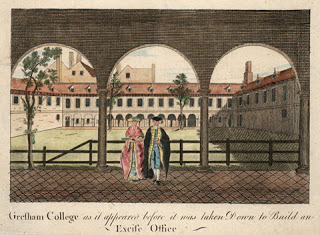
The first college location was Gresham's mansion in Bishopsgate where Tower 42 is now built. It stayed there until 1768, and next settled in 1842 in Gresham Street EC2. Gresham College did not become part of the University of London on the founding of the University in the 19th century, although a close association between the College and the University persisted for many years. Since 1991, the College has operated at Barnard's Inn Hall, Holborn EC1.
A look at recenlty past and upcoming lectures will show how varied the programs are:
Fakes, Completions and the Art of Borrowing - Professor Christopher Hogwood CBE - Date/Time: 25/01/2011, 1pm Venue: Museum of London
Although Mozart's unfinished Requiem is the most publicised composition requiring a helping-hand, there are many similar incomplete may-be masterpieces which have been assisted in some way, plus a number of well-loved classics which have very little connection with their supposed author ('Albinoni's Adagio' heads such a list). In addition composers of all periods have been open to the 'art of borrowing' - Handel was particularly active in this area and the reasons and results of his 'borrowings' shed a new light on some very familiar compositions.
The Victorians: Gender and Sexuality - Professor Richard J Evans - Date/Time: 14/02/2011, 6pm
Venue: Museum of London
'Victorian' came in the twentieth century to stand for sexual repression and social convention. Personal life was governed by complex and rigid rules of behaviour. Like other aspects of Victorian culture this began to break down in the fin-de-siécle. Yet recent research, discussed in this lecture, has undermined this rather simplistic picture and begun to explore some of the contradictions and complexities of Victorian attitudes to marriage and sexuality. The place of women in Victorian culture was by no means as passive or subordinate as conventional images of the era suggest.
The Gresham Astronomy Weekend - Professor Ian Morison - Date/Time: 18/03/2011 Venue: Farncombe Estate, The Cotswolds
The primary aim is to encourage newcomers to take up observational astronomy. There will be demonstrations of telescopes, planispheres and star charts, plus workshops and practical sessions for beginners, but more advanced amateurs are also welcome. There will be advice on astro-imaging using web-cams, digital cameras and dedicated CCD imagers. A set of annotated star charts will be provided. There is a charge for this event.
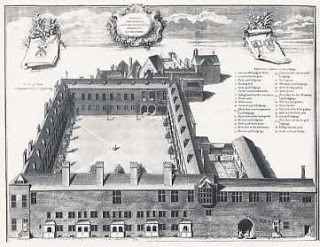 Engraving by George Vertue of Gresham College, looking east, showing the entrance in Old Broad Street, from John Ward's Lives of the Professors of Gresham College (1740).
Engraving by George Vertue of Gresham College, looking east, showing the entrance in Old Broad Street, from John Ward's Lives of the Professors of Gresham College (1740).
Published on February 18, 2011 00:58
February 17, 2011
Knebworth House Visit
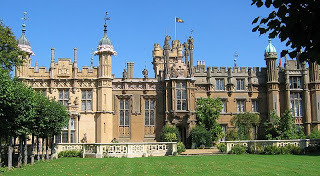 Knebworth House in Hertfordshire, just north of London, was the home of Edward Bulwer-Lytton (1803-1873), politician, statesman, and author of dozens of novels. Our tastes in literature have left poor B-L far, far behind. But his house is often a star in its own right, currently as the home of Logan Mountstuart's wife, Lottie (Lady Laeticia) and her father, the earl of Edgefield, in the series Any Human Heart on PBS's Masterpiece.
Knebworth House in Hertfordshire, just north of London, was the home of Edward Bulwer-Lytton (1803-1873), politician, statesman, and author of dozens of novels. Our tastes in literature have left poor B-L far, far behind. But his house is often a star in its own right, currently as the home of Logan Mountstuart's wife, Lottie (Lady Laeticia) and her father, the earl of Edgefield, in the series Any Human Heart on PBS's Masterpiece. Any Human Heart is based onWilliam Boyd's 2002 novel, subtitled The Intimate Journals of Logan Mountstuart. The story goes from Logan's coming of age through his lifetime. Though the novel is said to be a literary attempt to put political and social events into a personal context, the television version seems more to be an amazingly frequent set of encounters with famous persons, such as Miro, Hemingway, Wallis Simpson, James Joyce, et. al., while Logan has a series of life crises in which he usually turns out to be a cad.
Any Human Heart is based onWilliam Boyd's 2002 novel, subtitled The Intimate Journals of Logan Mountstuart. The story goes from Logan's coming of age through his lifetime. Though the novel is said to be a literary attempt to put political and social events into a personal context, the television version seems more to be an amazingly frequent set of encounters with famous persons, such as Miro, Hemingway, Wallis Simpson, James Joyce, et. al., while Logan has a series of life crises in which he usually turns out to be a cad.But the point of this post is the house, Knebworth, playing the role of fictional Thorpe Hall. Knebworth has been in many films and tv shows, including The King's Speech, and Batman, where it purports to be David Wayne's elegant manor. Kristine and Victoria, with a group of their friends, visited Knebworth on cloudy day a few years ago. The grey skies seemed a perfect background for the ornately gothic pile of yellowish sandstone. Take a look at the Knebworth website here.
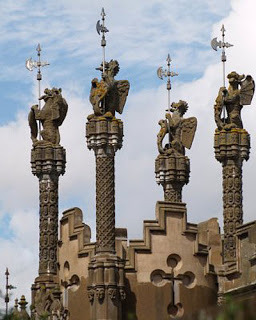 A mere thirty miles north of London, Knebworth House raises its ornate turrets, decorative crenellated chimneys and fanciful columns topped with heraldic beasts to the Hertfortshire sky. The Lytton family has occupied the property for more than 500 years.
A mere thirty miles north of London, Knebworth House raises its ornate turrets, decorative crenellated chimneys and fanciful columns topped with heraldic beasts to the Hertfortshire sky. The Lytton family has occupied the property for more than 500 years.Although every stately home in England has a fascinating history peopled with interesting inhabitants, Knebworth is particularly well endowed with eccentric, even tragic, characters. The medieval era house, with assorted changes, stood until the early 19th century. Freed from an unhappy marriage by the death of her husband, the redoubtable heiress, Elizabeth Lytton (1773-1843), made the first of extensive architectural changes in the early 19th century
 .
.She and General William Bulwer (1757-1807), had several children, the youngest of whom became Sir Edward Bulwer-Lytton, (1803-1873), probably the most famous family member, immortalized by Snoopy's efforts to begin his novel, "It was a dark and stormy night."
Elizabeth had three sides of the sprawling old structure demolished. The remaining side, preserving the ancient Banqueting Hall with its carved screen, was remodeled in the fashionable gothic style, with a medieval style towers and battlements.
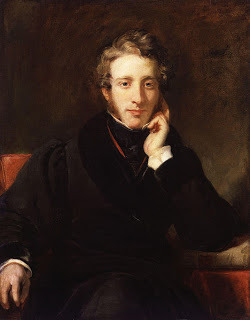 Bulwer-Lytton, a budding poet, had a love affair with Lady Caroline Lamb (known particularly for her pursuit of Lord Byron, the poet) in the 1820's. A copy of her notorious novel Glenarvon (1816) is on display at Knebworth inscribed by Bulwer-Lytton: "Poor Lady Caroline . . . she could not but inspire deep pity that was heightened by admirations for talents and qualities that well trained, might have made her one of the first women of her time."
Bulwer-Lytton, a budding poet, had a love affair with Lady Caroline Lamb (known particularly for her pursuit of Lord Byron, the poet) in the 1820's. A copy of her notorious novel Glenarvon (1816) is on display at Knebworth inscribed by Bulwer-Lytton: "Poor Lady Caroline . . . she could not but inspire deep pity that was heightened by admirations for talents and qualities that well trained, might have made her one of the first women of her time."Soon after the affair concluded and against the wishes of his mother, Bulwer-Lytton married Rosina Doyle Wheeler in 1827, one of the most disastrous mismatches of the era. Always short of funds, nevertheless they lived extravagantly. Their two children, a daughter, Emily, and a son, Teddy (later first Earl of Lytton), both suffered from the constant battles between their parents.
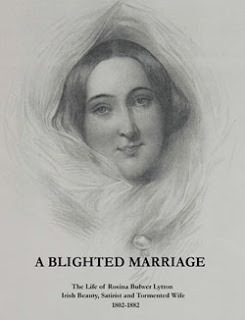 At times Rosina was banished from her husband's presence. Once, after she interrupted a political campaign meeting to denounce him, she was placed in a mental institution until public outrage brought her release. Rosina published thirteen novels and many other works on women's issues. Quoting the guidebook to the house (p. 11), "Ostracised (sic) by the family for a century, Rosina has now been readopted. Her contribution to the struggle for women's rights has been recognized . . . and the present Lord Cobbold (David Lytton Cobbald) named his daughter after her."
At times Rosina was banished from her husband's presence. Once, after she interrupted a political campaign meeting to denounce him, she was placed in a mental institution until public outrage brought her release. Rosina published thirteen novels and many other works on women's issues. Quoting the guidebook to the house (p. 11), "Ostracised (sic) by the family for a century, Rosina has now been readopted. Her contribution to the struggle for women's rights has been recognized . . . and the present Lord Cobbold (David Lytton Cobbald) named his daughter after her." 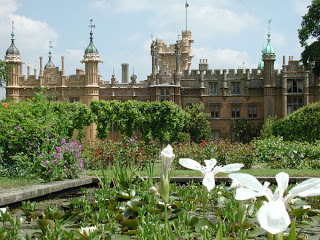 Bulwer-Lytton, a member of parliament, a journalist and playwright, as well as the author of seventy novels, did not live at Knebworth until after his mother's death in 1843. When he took over the estate, he began further changes to enhance Gothic elements of the house. Separated permanently from Rosina, he entertained frequently, often staging amateur and professional theatricals with his friend and fellow writer, Charles Dickens. In the sober library of the house, some of Bulwer-Lytton's novels are on display, the most famous of which is probably Last Days of Pompeii (1834).
Bulwer-Lytton, a member of parliament, a journalist and playwright, as well as the author of seventy novels, did not live at Knebworth until after his mother's death in 1843. When he took over the estate, he began further changes to enhance Gothic elements of the house. Separated permanently from Rosina, he entertained frequently, often staging amateur and professional theatricals with his friend and fellow writer, Charles Dickens. In the sober library of the house, some of Bulwer-Lytton's novels are on display, the most famous of which is probably Last Days of Pompeii (1834). 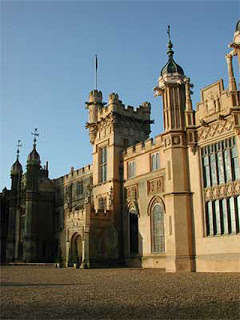 Additional changes to the house were made by his grandson, Victor, second earl of Lytton, with the help of his brother-in- law, the renowned architect Sir Edwin Lutyens. In addition to the fine ancient banqueting hall, today's visitors will enjoy the army's many suits of armor, the High Gothic State Drawing Room, and Elizabeth's regency-era bedroom, preserved as it was in her day at the request of her son. All the afore-mentioned persons are pictured in the extensive family portrait collection. The house gave me a rather melancholy impression, only partially offset by the handsome Knebworth gardens. Below are views of Knebworth, inside and out.
Additional changes to the house were made by his grandson, Victor, second earl of Lytton, with the help of his brother-in- law, the renowned architect Sir Edwin Lutyens. In addition to the fine ancient banqueting hall, today's visitors will enjoy the army's many suits of armor, the High Gothic State Drawing Room, and Elizabeth's regency-era bedroom, preserved as it was in her day at the request of her son. All the afore-mentioned persons are pictured in the extensive family portrait collection. The house gave me a rather melancholy impression, only partially offset by the handsome Knebworth gardens. Below are views of Knebworth, inside and out.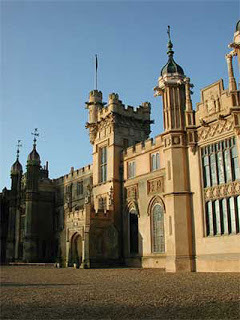 Entrance Hall
Entrance Hall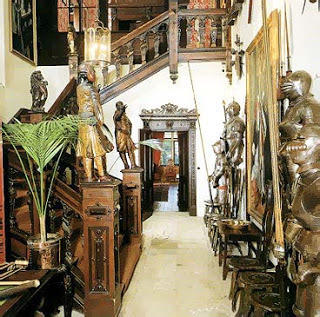 The Amoury
The Amoury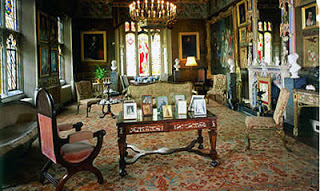
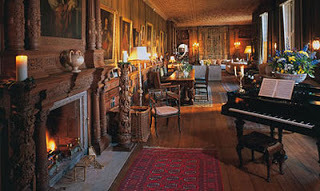
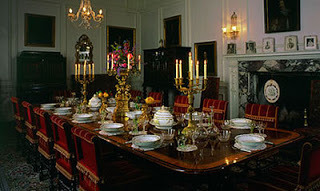

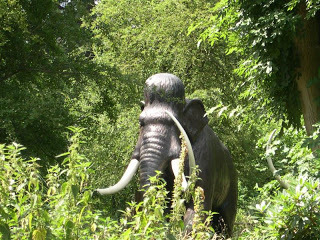 Two pictures above, the adventure playground woods
Two pictures above, the adventure playground woods Like so many stately homes in Britain, Knebworth House must pay its own way, and thus is not only a fascinating historical site and a rich source of settings for films. There are a variety of attractions for children, frequent corporate events and weddings, charity fetes and shows is all kinds (antiques, cars etc etec.) and many, many concerts, mostly rock music, with audiences upwards of 50,000. Dark and stormy it was not!
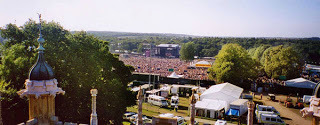
Published on February 17, 2011 02:00
February 16, 2011
Secret Southwark
Sometimes, the most interesting bits of history are right in front of us, but remain hidden from view because we're just too busy to take proper notice of them. Below, we point out a few of the hidden historical gems to be found in Southwark.
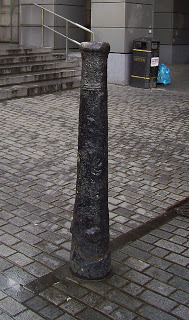 Originally, street bollards were adapted from the French cannons captured at the battle of Trafalgar in 1805. They were placed on street corners to stop the iron wagon wheels of carts from mounting the kerbs and doing damage and became so useful that bollards were installed throughout the City. Once the stock of authentic French cannons had been exhausted, copies were made and can still be seen on the streets of London today. The bollard pictured at left is an original French cannon which stands on the Southbank near to Shakespeare's Globe. For more information and photos, visit Bollards of London.
Originally, street bollards were adapted from the French cannons captured at the battle of Trafalgar in 1805. They were placed on street corners to stop the iron wagon wheels of carts from mounting the kerbs and doing damage and became so useful that bollards were installed throughout the City. Once the stock of authentic French cannons had been exhausted, copies were made and can still be seen on the streets of London today. The bollard pictured at left is an original French cannon which stands on the Southbank near to Shakespeare's Globe. For more information and photos, visit Bollards of London.
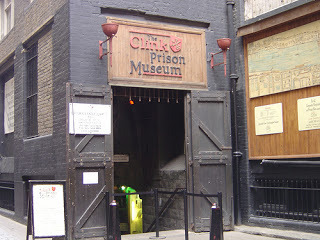 Hardly a secret since it's now a cheesey tourist attraction, the Clink Prison (1 Clink Street, Bankside) is still of note. The Clink Prison Museum is built upon the original site of the Clink Prison, which dates back to 1144 making it one of England's oldest, if not the oldest Prison.
Hardly a secret since it's now a cheesey tourist attraction, the Clink Prison (1 Clink Street, Bankside) is still of note. The Clink Prison Museum is built upon the original site of the Clink Prison, which dates back to 1144 making it one of England's oldest, if not the oldest Prison.
Owned by the Bishop of Winchester, the Clink Prison was used to control the Southbank of London known as "The Liberty of The Clink." This area housed much of London's entertainment establishments including four theatres, bull-baiting, bear-baiting, inns and many other darker entertainments, including prostitution, smuggling and murder - a fact that meant that the Clink was never short of inmates. In fact, it's still housing prisoners - in August 2006 an employee accidentally locked two tourists in the basement museum when locking up for the night and going home. They were released later that night after pressing the fire alarm. And they thought "You'll be thrown in the Clink" was just an old saying.
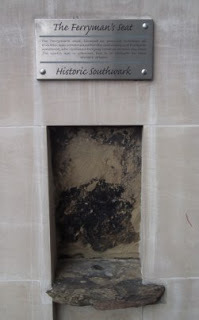
The Ferryman's Seat, Bear Gardens, Bankside is close by where Shakespeare's Globe now stands. Long ago when London's only river crossing was the London bridge, ferrymen waited to take people from one side of the shore to the other. On the South Bank stood many "Stews" the old name for brothels that were lined along this side of the river on the South Bank, as well as actors and troubadours who preformed at the Rose and the Globe theatres and the large crowds who came for the nearby bear baiting ring. Now set into the side of a modern building, the ferryman's seat stands in exactly the same spot where the ferrymen rested between fares.
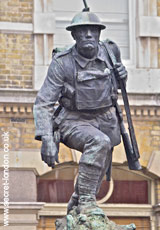
The Southwark War Memorial in Borough High Street was sculpted by Philip Lindsey Clark (1889-1977), a Captain during WWI who won the DSO before going back to study at the Royal Academy. This work of 1924 shows a soldier tramping through mud, while reliefs on each side show a biplane dogfight and a naval battle. A weeping wife and mother decorate the reverse.
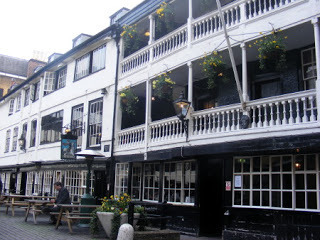 Again not exactly a secret, since it's still a popular pub and meeting place, The George Inn on Borough High Street is the last of London's galleried coaching inns. For centuries, Borough High Street was the terminus for coaches travelling to London from the south when the old London Bridge was too narrow for them to cross into the City. Passengers used to eat and sleep here while they waited to board the horse-drawn coaches which handled long distance travel in the days before the railways. Rooms occupied the galleries that encircled the courtyard where the coaches stopped while the horses were changed and the passengers got on and off. The George dates from 1676, when it replaced an earlier inn destroyed by fire. While the northern and central wings were demolished for the railway in 1889, the southern wing remains intact. In 1937, it was taken over by the National Trust, which oversaw its repair and restoration.
Again not exactly a secret, since it's still a popular pub and meeting place, The George Inn on Borough High Street is the last of London's galleried coaching inns. For centuries, Borough High Street was the terminus for coaches travelling to London from the south when the old London Bridge was too narrow for them to cross into the City. Passengers used to eat and sleep here while they waited to board the horse-drawn coaches which handled long distance travel in the days before the railways. Rooms occupied the galleries that encircled the courtyard where the coaches stopped while the horses were changed and the passengers got on and off. The George dates from 1676, when it replaced an earlier inn destroyed by fire. While the northern and central wings were demolished for the railway in 1889, the southern wing remains intact. In 1937, it was taken over by the National Trust, which oversaw its repair and restoration.
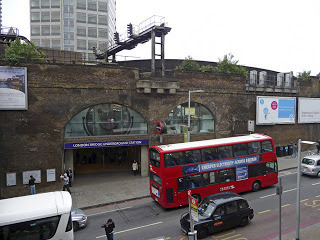 London Bridge Station has the honour of being the oldest railway station in London. It opened on 14 December 1836 as the terminus of the London and Greenwich Railway, the first steam-powered railway in London and the first in the world designed specifically to carry passengers. It ran along a viaduct consisting of 878 arches originally intended to be rented out for housing. Since 1839, when the London and Croydon Railway began operation, the station has consisted of two parts, each of which has been altered and expanded many times. Having suffered bomb damage during the Second World War, the station was rebuilt and reopened in 1978.
London Bridge Station has the honour of being the oldest railway station in London. It opened on 14 December 1836 as the terminus of the London and Greenwich Railway, the first steam-powered railway in London and the first in the world designed specifically to carry passengers. It ran along a viaduct consisting of 878 arches originally intended to be rented out for housing. Since 1839, when the London and Croydon Railway began operation, the station has consisted of two parts, each of which has been altered and expanded many times. Having suffered bomb damage during the Second World War, the station was rebuilt and reopened in 1978.
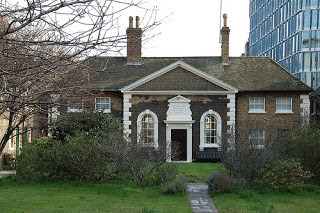 Brooke and I actually came across Hopton's Almshouses in June, when the gardens were alive with gorgeous roses. The Almshouses were founded by fishmonger Charles Hopton, who died in 1730. The 26 almshouses for 'poor decayed men' of the parish were erected in 1746-9 and opened in 1752. The residents, who included gardeners, watermen and fishermen were also granted £6 per year and 32 bushels of coal. In 1825 two extra houses were added. The complex includes two garden squares with centre lawns and roses, edged with shrubs. Outside the gates is a drinking fountain and cattle trough. The almshouses were rebuilt and modernised in 1988 and are used for housing, administered by The Anchor Trust.
Brooke and I actually came across Hopton's Almshouses in June, when the gardens were alive with gorgeous roses. The Almshouses were founded by fishmonger Charles Hopton, who died in 1730. The 26 almshouses for 'poor decayed men' of the parish were erected in 1746-9 and opened in 1752. The residents, who included gardeners, watermen and fishermen were also granted £6 per year and 32 bushels of coal. In 1825 two extra houses were added. The complex includes two garden squares with centre lawns and roses, edged with shrubs. Outside the gates is a drinking fountain and cattle trough. The almshouses were rebuilt and modernised in 1988 and are used for housing, administered by The Anchor Trust.
 Originally, street bollards were adapted from the French cannons captured at the battle of Trafalgar in 1805. They were placed on street corners to stop the iron wagon wheels of carts from mounting the kerbs and doing damage and became so useful that bollards were installed throughout the City. Once the stock of authentic French cannons had been exhausted, copies were made and can still be seen on the streets of London today. The bollard pictured at left is an original French cannon which stands on the Southbank near to Shakespeare's Globe. For more information and photos, visit Bollards of London.
Originally, street bollards were adapted from the French cannons captured at the battle of Trafalgar in 1805. They were placed on street corners to stop the iron wagon wheels of carts from mounting the kerbs and doing damage and became so useful that bollards were installed throughout the City. Once the stock of authentic French cannons had been exhausted, copies were made and can still be seen on the streets of London today. The bollard pictured at left is an original French cannon which stands on the Southbank near to Shakespeare's Globe. For more information and photos, visit Bollards of London.  Hardly a secret since it's now a cheesey tourist attraction, the Clink Prison (1 Clink Street, Bankside) is still of note. The Clink Prison Museum is built upon the original site of the Clink Prison, which dates back to 1144 making it one of England's oldest, if not the oldest Prison.
Hardly a secret since it's now a cheesey tourist attraction, the Clink Prison (1 Clink Street, Bankside) is still of note. The Clink Prison Museum is built upon the original site of the Clink Prison, which dates back to 1144 making it one of England's oldest, if not the oldest Prison. Owned by the Bishop of Winchester, the Clink Prison was used to control the Southbank of London known as "The Liberty of The Clink." This area housed much of London's entertainment establishments including four theatres, bull-baiting, bear-baiting, inns and many other darker entertainments, including prostitution, smuggling and murder - a fact that meant that the Clink was never short of inmates. In fact, it's still housing prisoners - in August 2006 an employee accidentally locked two tourists in the basement museum when locking up for the night and going home. They were released later that night after pressing the fire alarm. And they thought "You'll be thrown in the Clink" was just an old saying.

The Ferryman's Seat, Bear Gardens, Bankside is close by where Shakespeare's Globe now stands. Long ago when London's only river crossing was the London bridge, ferrymen waited to take people from one side of the shore to the other. On the South Bank stood many "Stews" the old name for brothels that were lined along this side of the river on the South Bank, as well as actors and troubadours who preformed at the Rose and the Globe theatres and the large crowds who came for the nearby bear baiting ring. Now set into the side of a modern building, the ferryman's seat stands in exactly the same spot where the ferrymen rested between fares.

The Southwark War Memorial in Borough High Street was sculpted by Philip Lindsey Clark (1889-1977), a Captain during WWI who won the DSO before going back to study at the Royal Academy. This work of 1924 shows a soldier tramping through mud, while reliefs on each side show a biplane dogfight and a naval battle. A weeping wife and mother decorate the reverse.
 Again not exactly a secret, since it's still a popular pub and meeting place, The George Inn on Borough High Street is the last of London's galleried coaching inns. For centuries, Borough High Street was the terminus for coaches travelling to London from the south when the old London Bridge was too narrow for them to cross into the City. Passengers used to eat and sleep here while they waited to board the horse-drawn coaches which handled long distance travel in the days before the railways. Rooms occupied the galleries that encircled the courtyard where the coaches stopped while the horses were changed and the passengers got on and off. The George dates from 1676, when it replaced an earlier inn destroyed by fire. While the northern and central wings were demolished for the railway in 1889, the southern wing remains intact. In 1937, it was taken over by the National Trust, which oversaw its repair and restoration.
Again not exactly a secret, since it's still a popular pub and meeting place, The George Inn on Borough High Street is the last of London's galleried coaching inns. For centuries, Borough High Street was the terminus for coaches travelling to London from the south when the old London Bridge was too narrow for them to cross into the City. Passengers used to eat and sleep here while they waited to board the horse-drawn coaches which handled long distance travel in the days before the railways. Rooms occupied the galleries that encircled the courtyard where the coaches stopped while the horses were changed and the passengers got on and off. The George dates from 1676, when it replaced an earlier inn destroyed by fire. While the northern and central wings were demolished for the railway in 1889, the southern wing remains intact. In 1937, it was taken over by the National Trust, which oversaw its repair and restoration. London Bridge Station has the honour of being the oldest railway station in London. It opened on 14 December 1836 as the terminus of the London and Greenwich Railway, the first steam-powered railway in London and the first in the world designed specifically to carry passengers. It ran along a viaduct consisting of 878 arches originally intended to be rented out for housing. Since 1839, when the London and Croydon Railway began operation, the station has consisted of two parts, each of which has been altered and expanded many times. Having suffered bomb damage during the Second World War, the station was rebuilt and reopened in 1978.
London Bridge Station has the honour of being the oldest railway station in London. It opened on 14 December 1836 as the terminus of the London and Greenwich Railway, the first steam-powered railway in London and the first in the world designed specifically to carry passengers. It ran along a viaduct consisting of 878 arches originally intended to be rented out for housing. Since 1839, when the London and Croydon Railway began operation, the station has consisted of two parts, each of which has been altered and expanded many times. Having suffered bomb damage during the Second World War, the station was rebuilt and reopened in 1978. Brooke and I actually came across Hopton's Almshouses in June, when the gardens were alive with gorgeous roses. The Almshouses were founded by fishmonger Charles Hopton, who died in 1730. The 26 almshouses for 'poor decayed men' of the parish were erected in 1746-9 and opened in 1752. The residents, who included gardeners, watermen and fishermen were also granted £6 per year and 32 bushels of coal. In 1825 two extra houses were added. The complex includes two garden squares with centre lawns and roses, edged with shrubs. Outside the gates is a drinking fountain and cattle trough. The almshouses were rebuilt and modernised in 1988 and are used for housing, administered by The Anchor Trust.
Brooke and I actually came across Hopton's Almshouses in June, when the gardens were alive with gorgeous roses. The Almshouses were founded by fishmonger Charles Hopton, who died in 1730. The 26 almshouses for 'poor decayed men' of the parish were erected in 1746-9 and opened in 1752. The residents, who included gardeners, watermen and fishermen were also granted £6 per year and 32 bushels of coal. In 1825 two extra houses were added. The complex includes two garden squares with centre lawns and roses, edged with shrubs. Outside the gates is a drinking fountain and cattle trough. The almshouses were rebuilt and modernised in 1988 and are used for housing, administered by The Anchor Trust.
Published on February 16, 2011 00:45
February 15, 2011
Royal Wedding Weekend Getaway Plans
Not content to settle for an extra Bank Holiday and late openings for pubs on the Royal Wedding Day (RWD), airlines and hoteliers are offering extended getaway specials themed around the Big Day. British Airways is offering Royal Wedding weekend packages and London hotels have been raising their room rates over the weekend accordingly, but really, anyone can book a BA flight or a room at the Savoy, no matter how inflated the cost. So, we've rounded up some unique options for the big RWD, each with its own twist on the festivities and all far away from the madding RWD crowds. Book early!
 Why not book yourself into the Celtic Manor Resort, where they'll be throwing a RWD Street party? Their website invites us to "join (them) to celebrate the Royal Wedding in the most traditional British way, with a spectacular outdoor 'street party' with live entertainment and big screens to watch the wedding celebrations, in the glorious surroundings of the Rooftop Garden. Immerse yourself in nostalgia with Union Jack bunting and trestle tables laden with tasty treats including jam sandwiches, homemade pork pies, Scotch eggs and sausage rolls, along with favourites such as Victoria sponge, fondant fancies, trifle and of course, traditional wedding cake." This Five Star Welsh resort features award winning dining, the Forum Spa and was home to the 2010 Ryder Cup.
Why not book yourself into the Celtic Manor Resort, where they'll be throwing a RWD Street party? Their website invites us to "join (them) to celebrate the Royal Wedding in the most traditional British way, with a spectacular outdoor 'street party' with live entertainment and big screens to watch the wedding celebrations, in the glorious surroundings of the Rooftop Garden. Immerse yourself in nostalgia with Union Jack bunting and trestle tables laden with tasty treats including jam sandwiches, homemade pork pies, Scotch eggs and sausage rolls, along with favourites such as Victoria sponge, fondant fancies, trifle and of course, traditional wedding cake." This Five Star Welsh resort features award winning dining, the Forum Spa and was home to the 2010 Ryder Cup.
 Forget the RWD, The Castle Hotel in Taunton, Somerset, is offering a Royal Honeymoon package to die for - it includes penthouse accommodation, a private butler, massage, flowers, wine and . . . a throne. I've stayed here and it's just lovely. Of course, I didn't have a butler. Or a massage. But it was still lovely.
Forget the RWD, The Castle Hotel in Taunton, Somerset, is offering a Royal Honeymoon package to die for - it includes penthouse accommodation, a private butler, massage, flowers, wine and . . . a throne. I've stayed here and it's just lovely. Of course, I didn't have a butler. Or a massage. But it was still lovely.
Personally, the offer from the Ambassador Bed and Breakfast in Brighton sounds like a hoot - book into the gay friendly hotel for a minimum of 3 nights over the Royal Wedding weekend and you'll be invited - at no extra cost - to join them at a garden party where you'll watch the wedding and be treated to a free buffet lunch, afternoon tea and wedding cake.
Even Grand Rapids, Michigan is getting in on the weekend wedding getaway deals, which isn't as far fetched as it seems once you realize that the exhibit, "Diana - A Celebration" will be in town over that weekend, with items on loan from the Spencer family.
 And lastly, if you want to do the Royal Wedding in royal style stateside, The Trump International Hotel and Tower in Chicago has announced the "Trump Royal Wedding Experience" where guests will watch the televised version of the Royal Wedding during an exclusive breakfast at the Michelin three-star restaurant Here's the description from the official press release: "After a night of ultimate comfort in a newly renovated guest room designed by Ivanka Trump, guests will descend to Jean Georges for an exclusive breakfast in the restaurant's main dining room starting at 5 a.m. A special tasting menu fit for a prince or princess will include selections like scrambled eggs with caviar, mini-French toast, and pains au chocolat. Guests will toast the royal couple with sparkling mimosas as they watch the Royal Wedding on monitors strategically placed around the dining room. The breakfast event will conclude by 9 a.m., at which time guests may choose to hit the town or return to their rooms for a nap. A 4 p.m. late checkout is guaranteed. As a memento of the occasion, each guest will receive a piece of official Royal Wedding china commissioned by The Royal Collection." What, no massage?
And lastly, if you want to do the Royal Wedding in royal style stateside, The Trump International Hotel and Tower in Chicago has announced the "Trump Royal Wedding Experience" where guests will watch the televised version of the Royal Wedding during an exclusive breakfast at the Michelin three-star restaurant Here's the description from the official press release: "After a night of ultimate comfort in a newly renovated guest room designed by Ivanka Trump, guests will descend to Jean Georges for an exclusive breakfast in the restaurant's main dining room starting at 5 a.m. A special tasting menu fit for a prince or princess will include selections like scrambled eggs with caviar, mini-French toast, and pains au chocolat. Guests will toast the royal couple with sparkling mimosas as they watch the Royal Wedding on monitors strategically placed around the dining room. The breakfast event will conclude by 9 a.m., at which time guests may choose to hit the town or return to their rooms for a nap. A 4 p.m. late checkout is guaranteed. As a memento of the occasion, each guest will receive a piece of official Royal Wedding china commissioned by The Royal Collection." What, no massage?
 Why not book yourself into the Celtic Manor Resort, where they'll be throwing a RWD Street party? Their website invites us to "join (them) to celebrate the Royal Wedding in the most traditional British way, with a spectacular outdoor 'street party' with live entertainment and big screens to watch the wedding celebrations, in the glorious surroundings of the Rooftop Garden. Immerse yourself in nostalgia with Union Jack bunting and trestle tables laden with tasty treats including jam sandwiches, homemade pork pies, Scotch eggs and sausage rolls, along with favourites such as Victoria sponge, fondant fancies, trifle and of course, traditional wedding cake." This Five Star Welsh resort features award winning dining, the Forum Spa and was home to the 2010 Ryder Cup.
Why not book yourself into the Celtic Manor Resort, where they'll be throwing a RWD Street party? Their website invites us to "join (them) to celebrate the Royal Wedding in the most traditional British way, with a spectacular outdoor 'street party' with live entertainment and big screens to watch the wedding celebrations, in the glorious surroundings of the Rooftop Garden. Immerse yourself in nostalgia with Union Jack bunting and trestle tables laden with tasty treats including jam sandwiches, homemade pork pies, Scotch eggs and sausage rolls, along with favourites such as Victoria sponge, fondant fancies, trifle and of course, traditional wedding cake." This Five Star Welsh resort features award winning dining, the Forum Spa and was home to the 2010 Ryder Cup.  Forget the RWD, The Castle Hotel in Taunton, Somerset, is offering a Royal Honeymoon package to die for - it includes penthouse accommodation, a private butler, massage, flowers, wine and . . . a throne. I've stayed here and it's just lovely. Of course, I didn't have a butler. Or a massage. But it was still lovely.
Forget the RWD, The Castle Hotel in Taunton, Somerset, is offering a Royal Honeymoon package to die for - it includes penthouse accommodation, a private butler, massage, flowers, wine and . . . a throne. I've stayed here and it's just lovely. Of course, I didn't have a butler. Or a massage. But it was still lovely. Personally, the offer from the Ambassador Bed and Breakfast in Brighton sounds like a hoot - book into the gay friendly hotel for a minimum of 3 nights over the Royal Wedding weekend and you'll be invited - at no extra cost - to join them at a garden party where you'll watch the wedding and be treated to a free buffet lunch, afternoon tea and wedding cake.
Even Grand Rapids, Michigan is getting in on the weekend wedding getaway deals, which isn't as far fetched as it seems once you realize that the exhibit, "Diana - A Celebration" will be in town over that weekend, with items on loan from the Spencer family.
 And lastly, if you want to do the Royal Wedding in royal style stateside, The Trump International Hotel and Tower in Chicago has announced the "Trump Royal Wedding Experience" where guests will watch the televised version of the Royal Wedding during an exclusive breakfast at the Michelin three-star restaurant Here's the description from the official press release: "After a night of ultimate comfort in a newly renovated guest room designed by Ivanka Trump, guests will descend to Jean Georges for an exclusive breakfast in the restaurant's main dining room starting at 5 a.m. A special tasting menu fit for a prince or princess will include selections like scrambled eggs with caviar, mini-French toast, and pains au chocolat. Guests will toast the royal couple with sparkling mimosas as they watch the Royal Wedding on monitors strategically placed around the dining room. The breakfast event will conclude by 9 a.m., at which time guests may choose to hit the town or return to their rooms for a nap. A 4 p.m. late checkout is guaranteed. As a memento of the occasion, each guest will receive a piece of official Royal Wedding china commissioned by The Royal Collection." What, no massage?
And lastly, if you want to do the Royal Wedding in royal style stateside, The Trump International Hotel and Tower in Chicago has announced the "Trump Royal Wedding Experience" where guests will watch the televised version of the Royal Wedding during an exclusive breakfast at the Michelin three-star restaurant Here's the description from the official press release: "After a night of ultimate comfort in a newly renovated guest room designed by Ivanka Trump, guests will descend to Jean Georges for an exclusive breakfast in the restaurant's main dining room starting at 5 a.m. A special tasting menu fit for a prince or princess will include selections like scrambled eggs with caviar, mini-French toast, and pains au chocolat. Guests will toast the royal couple with sparkling mimosas as they watch the Royal Wedding on monitors strategically placed around the dining room. The breakfast event will conclude by 9 a.m., at which time guests may choose to hit the town or return to their rooms for a nap. A 4 p.m. late checkout is guaranteed. As a memento of the occasion, each guest will receive a piece of official Royal Wedding china commissioned by The Royal Collection." What, no massage?
Published on February 15, 2011 00:56
February 14, 2011
Valentines Day 1829
Bell's World of Fashion
A MONTHLY MAGAZINE DEDICATED EXPRESSLY TO HIGH LIFE, FASHIONABLES, AND FASHIONS, POLITE LITERATURE, FINE ARTS, THE OPERA, THEATRES, No. 56.
LONDON, FEBRUARY 1, 1829.
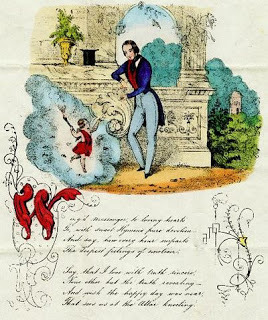
"Good morrow to my Valentine," sings the poor Ophelia. "Good morrow! 'tis St. Valentine's day, all in the morning betime, and I a maid at your window to be your Valentine!
Rude as these lines may be, they are sacred for they are Shakspeare's, one of the wild and beautiful snatches of song, which are drawn from the heart of the love torn, riven-hearted maid of Denmark! It, moreover, celebrates a custom in the olden time, of looking for a Valentine through your bed-room window, which has partially descended to us, by the first person we see, of the opposite sex, on this festive morning, being Our Valentine.
Our fair readers will perhaps be gratified with a few reminiscences of the practices in former periods, on this
day, from which originated our Valentines. It was the practice in ancient Rome, during a great part of the month of February, to celebrate the Lupercalia, which were feasts in honour of the deities Pan and Juno. On this occasion, among a variety of other festive ceremonies, the names of all the young females were put into a box, from which they were drawn by the men, as chance directed. The pastors of the early Christian church, who by every possible means endeavoured to eradicate the vestiges of pagan superstitions, substituted the names of saints for those of women; and, as the feast of the Lupercalia had commenced about the middle
of February, they chose a saint's day for the purpose of celebrating it. As it was, however, impossible to extirpate altogether any ceremony to which the people had been so long accustomed, especially one which was so consonant to their feelings, as the original Lupercalia, the practice of choosing partners or sweethearts, was kept up, and, from the day upon which it was celebrated, all persons so chosen
were called Valentines.
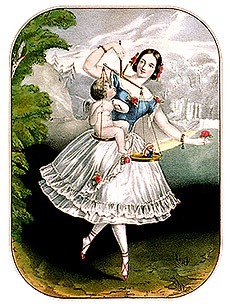
And now we will record some of our own customs peculiar to Saint Valentine. In many parts of England and
Scotland, an equal number of maidens and bachelors assemble together, and each write their name upon separate scraps of paper, which are all rolled up and put into bags; the papers are then drawn, and each young man lights upon a female who is to be his Valentine. The company being thus divided into so many happy, laughing couples, the gentlemen give balls and other amusements to their mistresses, and wear the paper with the lady's name subscribed on it, upon their bosom or sleeve. The festival is kept up several days, and we need scarcely add that this little amusement generally ends in love!
In some parts of Kent they have a curious kind of sport on Valentine's Day. The young girls of the diiferent villages construct a figure, which they call an ivy girl, while the young men make up another figure, which is denominated a holly boy, and after amusing themselves therewith, the girls steal the holly boy and burn him, and the men run away with the ivy girl, and serve her in a similar manner. The origin, or the meaning of this amusement, we confess ourselves at a loss to guess.
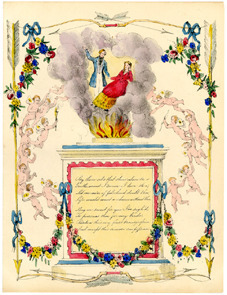
Who would not wish to receive a Valentine? Who is there so dead to all the fascinations of beauty, all the
endearments and allurements of life, as to refuse paying two-pence or three-pence, or whatever it may be, for one of those neat folded, tale telling, blissful billets, even though it should contain nothing more than two hearts transfixed with a dart, or a true lover's knot, and a poesy from the song, " If you loves I as I loves you,
no knife shall cut our love in two."
Who, I enquire, is there that would not feel delighted by any of these tender morceaux? Does it not plainly evidence that there are persons who feel a warm and ardent interest in your welfare, and, humble as the scrap may be, is it not a Valentine? and ought you not to be thankful?
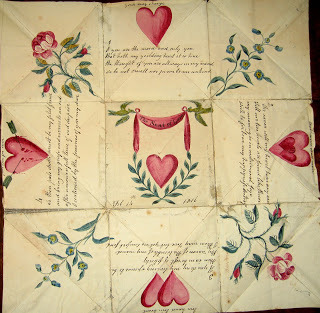
If such simple prettynesses then are to be esteemed, what are we to say of the bright and gorgeous emanations of the artist's pencil, the glittering and highly wrought bijouterie which adorn the windows of our fancy stationers, and are more splendid than the beautiful annual pocket-books which we should never touch but with new gloves on our hands, for fear of sullying their brilliancy. Roses, which unfolding, discover gorgeous temples, sparkling in gold and glitter, surmounted with bands of little cherubs that seem starting into life, and quaint devices, which speak more forcibly to the heart than the finest poetry of Byron or of Moore. Wreaths and bouquets of flowers, with Cupids springing from the leaves, painted in the finest style of art,
the symbolical flowers arranged in an expressive manner; honeysuckle and jasmine twining fondly round the lilies, roses, and other beauty blossoms, with the little meek and blue-eyed " Forget Me Not," peering from between its more splendid compeers, but rivalling all in beautiful allusion. What a present for a lover ! how dearly does his lady esteem it! how fondly does she press the bright gem to her heart, and willingly believe its silent eloquence, the tender avowal of this pledge of love!
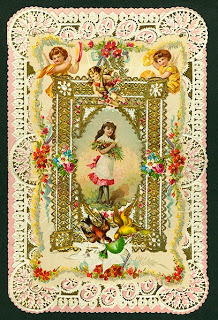
The practice of sending Valentines is not confined to one class or body of persons, for the same disposition is found in every rank of life; and every juvenile, as soon as he is old enough to fancy himself in love, thinks it very necessary to write Valentines. Nay, every village clodhopper must also have one for his charming Moggy Dumpling, or Betsy Blossom, and "comes up to town 'ith' waggon," on purpose to buy the prettiest, and have a "real Lonnon one." With what a happy face he enters the stationer's shop, and enquires for a "nice looking Woluntine," and after he has turned over some score or two of cupids, and hearts, and churches, and lovers knots, at length pounces upon one which tickles his fancy, and chuckling to himself, with what a triumphant air he ulls out his leather pouch, and throws down the demanded sixpence; then borrowing a
pen and ink, he scribbles under the gaudy-coloured picture,
" I'll be your'n if you'll be mine, So be my charming Woluntine."
Afterwards, begging the shopkeeper to fold it up nicely for him, he sallies out of the shop with as much pride and consequence as if he had been made high constable of his parish . . . .
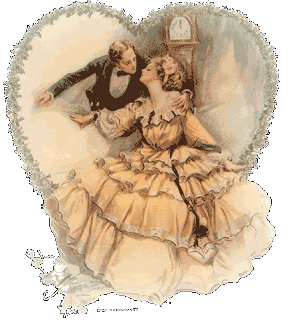 * Two hundred thousand letters, above and beyond the usual daily average, annually pass through the two-penny post-office in London alone, on St. Valentine's day. What a tiribe of lovers!
* Two hundred thousand letters, above and beyond the usual daily average, annually pass through the two-penny post-office in London alone, on St. Valentine's day. What a tiribe of lovers!
A MONTHLY MAGAZINE DEDICATED EXPRESSLY TO HIGH LIFE, FASHIONABLES, AND FASHIONS, POLITE LITERATURE, FINE ARTS, THE OPERA, THEATRES, No. 56.
LONDON, FEBRUARY 1, 1829.

"Good morrow to my Valentine," sings the poor Ophelia. "Good morrow! 'tis St. Valentine's day, all in the morning betime, and I a maid at your window to be your Valentine!
Rude as these lines may be, they are sacred for they are Shakspeare's, one of the wild and beautiful snatches of song, which are drawn from the heart of the love torn, riven-hearted maid of Denmark! It, moreover, celebrates a custom in the olden time, of looking for a Valentine through your bed-room window, which has partially descended to us, by the first person we see, of the opposite sex, on this festive morning, being Our Valentine.
Our fair readers will perhaps be gratified with a few reminiscences of the practices in former periods, on this
day, from which originated our Valentines. It was the practice in ancient Rome, during a great part of the month of February, to celebrate the Lupercalia, which were feasts in honour of the deities Pan and Juno. On this occasion, among a variety of other festive ceremonies, the names of all the young females were put into a box, from which they were drawn by the men, as chance directed. The pastors of the early Christian church, who by every possible means endeavoured to eradicate the vestiges of pagan superstitions, substituted the names of saints for those of women; and, as the feast of the Lupercalia had commenced about the middle
of February, they chose a saint's day for the purpose of celebrating it. As it was, however, impossible to extirpate altogether any ceremony to which the people had been so long accustomed, especially one which was so consonant to their feelings, as the original Lupercalia, the practice of choosing partners or sweethearts, was kept up, and, from the day upon which it was celebrated, all persons so chosen
were called Valentines.

And now we will record some of our own customs peculiar to Saint Valentine. In many parts of England and
Scotland, an equal number of maidens and bachelors assemble together, and each write their name upon separate scraps of paper, which are all rolled up and put into bags; the papers are then drawn, and each young man lights upon a female who is to be his Valentine. The company being thus divided into so many happy, laughing couples, the gentlemen give balls and other amusements to their mistresses, and wear the paper with the lady's name subscribed on it, upon their bosom or sleeve. The festival is kept up several days, and we need scarcely add that this little amusement generally ends in love!
In some parts of Kent they have a curious kind of sport on Valentine's Day. The young girls of the diiferent villages construct a figure, which they call an ivy girl, while the young men make up another figure, which is denominated a holly boy, and after amusing themselves therewith, the girls steal the holly boy and burn him, and the men run away with the ivy girl, and serve her in a similar manner. The origin, or the meaning of this amusement, we confess ourselves at a loss to guess.

Who would not wish to receive a Valentine? Who is there so dead to all the fascinations of beauty, all the
endearments and allurements of life, as to refuse paying two-pence or three-pence, or whatever it may be, for one of those neat folded, tale telling, blissful billets, even though it should contain nothing more than two hearts transfixed with a dart, or a true lover's knot, and a poesy from the song, " If you loves I as I loves you,
no knife shall cut our love in two."
Who, I enquire, is there that would not feel delighted by any of these tender morceaux? Does it not plainly evidence that there are persons who feel a warm and ardent interest in your welfare, and, humble as the scrap may be, is it not a Valentine? and ought you not to be thankful?

If such simple prettynesses then are to be esteemed, what are we to say of the bright and gorgeous emanations of the artist's pencil, the glittering and highly wrought bijouterie which adorn the windows of our fancy stationers, and are more splendid than the beautiful annual pocket-books which we should never touch but with new gloves on our hands, for fear of sullying their brilliancy. Roses, which unfolding, discover gorgeous temples, sparkling in gold and glitter, surmounted with bands of little cherubs that seem starting into life, and quaint devices, which speak more forcibly to the heart than the finest poetry of Byron or of Moore. Wreaths and bouquets of flowers, with Cupids springing from the leaves, painted in the finest style of art,
the symbolical flowers arranged in an expressive manner; honeysuckle and jasmine twining fondly round the lilies, roses, and other beauty blossoms, with the little meek and blue-eyed " Forget Me Not," peering from between its more splendid compeers, but rivalling all in beautiful allusion. What a present for a lover ! how dearly does his lady esteem it! how fondly does she press the bright gem to her heart, and willingly believe its silent eloquence, the tender avowal of this pledge of love!

The practice of sending Valentines is not confined to one class or body of persons, for the same disposition is found in every rank of life; and every juvenile, as soon as he is old enough to fancy himself in love, thinks it very necessary to write Valentines. Nay, every village clodhopper must also have one for his charming Moggy Dumpling, or Betsy Blossom, and "comes up to town 'ith' waggon," on purpose to buy the prettiest, and have a "real Lonnon one." With what a happy face he enters the stationer's shop, and enquires for a "nice looking Woluntine," and after he has turned over some score or two of cupids, and hearts, and churches, and lovers knots, at length pounces upon one which tickles his fancy, and chuckling to himself, with what a triumphant air he ulls out his leather pouch, and throws down the demanded sixpence; then borrowing a
pen and ink, he scribbles under the gaudy-coloured picture,
" I'll be your'n if you'll be mine, So be my charming Woluntine."
Afterwards, begging the shopkeeper to fold it up nicely for him, he sallies out of the shop with as much pride and consequence as if he had been made high constable of his parish . . . .
 * Two hundred thousand letters, above and beyond the usual daily average, annually pass through the two-penny post-office in London alone, on St. Valentine's day. What a tiribe of lovers!
* Two hundred thousand letters, above and beyond the usual daily average, annually pass through the two-penny post-office in London alone, on St. Valentine's day. What a tiribe of lovers!
Published on February 14, 2011 01:21
February 13, 2011
More Royal Wedding Gowns
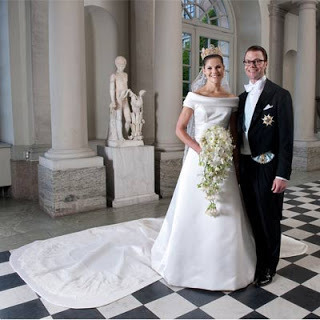 This is really just a collection of pretty wedding pictures and gorgeous dresses. But, since it's on our minds, these days, why not???? Some of these brides are related to the U.K. royals, others from European families. At right is Crown Princess Victoria of Sweden with her husband, Daniel Wrestling. They were married in Stockholm in June, 2010.
This is really just a collection of pretty wedding pictures and gorgeous dresses. But, since it's on our minds, these days, why not???? Some of these brides are related to the U.K. royals, others from European families. At right is Crown Princess Victoria of Sweden with her husband, Daniel Wrestling. They were married in Stockholm in June, 2010.The dress is elegantly simple and looks perfect on Princess Victoria. Only the tiara -- though it looks more like a crown -- is elaborately decorated.
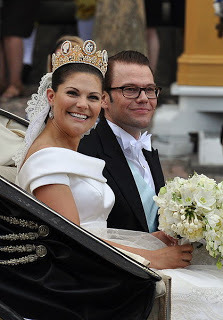
Crown Princess Victoria Ingrid Alice Désirée was in 1977. She will become Queen of Sweden upon the death of her father, King Carl XIV Gustav. through her father, Victoria is related to the British royals and actually occupies a position in the line of U.K. royal succession. Now known as HRH Prince Daniel, Duke of Vastergotland, Victoria's husband is her former personal trainer and ran a company owning several gyms.
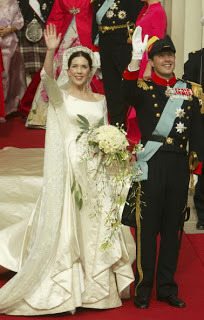
Another Scandinavian royal wedding was in Copenhagen Denmark on May 14, 2005, when HRH Crown Prince Frederik married Mary Donaldson, an Australian. They recently had twins, in January, 2011, a boy and a girl. Their older siblings are Prince Christian, born in 2005, and Princess Isabella, born in 2007.
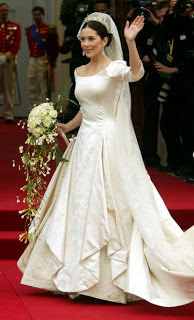
Crown Princess Mary made a beautiful bride and her dress was picture perfect. The overskirt draping makes graceful detailing near the hem, rather an unusual but pleasing feature.
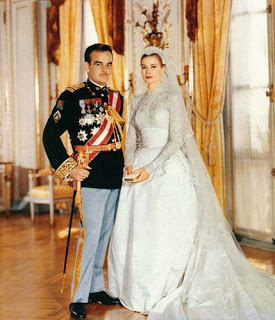 Hollywood royalty was united with royalty from the tiny but rich principality of Monaco when film star Grace Kelly married Prince Rainer in 1956.The very nigh neckline of the gown amused many observers who were well aware of Kelly's reputation for behaving entirely contrary to her look of a perfectly-proper ice queen. Princess Grace, mother of three royal children, died in a car crash in 1982. The Prince died in 2005.
Hollywood royalty was united with royalty from the tiny but rich principality of Monaco when film star Grace Kelly married Prince Rainer in 1956.The very nigh neckline of the gown amused many observers who were well aware of Kelly's reputation for behaving entirely contrary to her look of a perfectly-proper ice queen. Princess Grace, mother of three royal children, died in a car crash in 1982. The Prince died in 2005.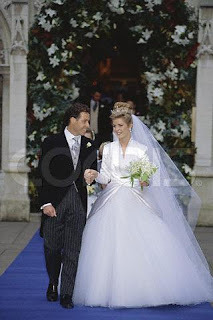 David Armstrong-Jones, Viscount Linley, married Hon. Serena Stanhope in October of 1993 at St. Margaret's, Westminster. He runs a thriving furniture business with a showroom in Pimlico which is quite fun to visit. Fashion observers noted how the gown, by Bruce Bobbins, resembled the neckline design of Princess Margaret's gown from 1960. The Viscount is Margaret's eldest child. The Linleys have two children, Charles, born 1999, and Margarita, born 2002.
David Armstrong-Jones, Viscount Linley, married Hon. Serena Stanhope in October of 1993 at St. Margaret's, Westminster. He runs a thriving furniture business with a showroom in Pimlico which is quite fun to visit. Fashion observers noted how the gown, by Bruce Bobbins, resembled the neckline design of Princess Margaret's gown from 1960. The Viscount is Margaret's eldest child. The Linleys have two children, Charles, born 1999, and Margarita, born 2002.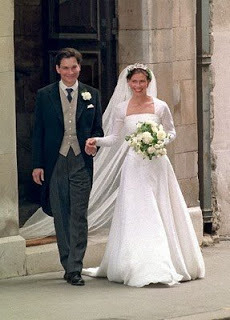 The very next year, Princess Margaret's daughter Lady Sarah Armstrong-Jones married actor Daniel Chatto at St Stephen Walbrook in the City of London on July 14, 1994. Her gown by Jasper Conran is elegantly traditional, though the venue for the ceremony was unusual for a member of the royal family. The Chattos have two sons, born in 1996 and 1999.
The very next year, Princess Margaret's daughter Lady Sarah Armstrong-Jones married actor Daniel Chatto at St Stephen Walbrook in the City of London on July 14, 1994. Her gown by Jasper Conran is elegantly traditional, though the venue for the ceremony was unusual for a member of the royal family. The Chattos have two sons, born in 1996 and 1999.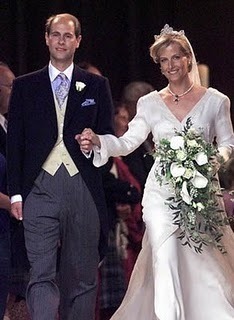 The last of Queen Elizabeth II's sons to wed was Prince Edward. He married Sophie Rhys-Jones in 1999 at St. George's Chapel, Windsor Castle. They are titled the Earl and Countess of Wessex. The gown was designed by Samantha Shaw. The Wessexes have two children, Lady Louise, born 2003, and James, Viscount Severn, born in 2007.
The last of Queen Elizabeth II's sons to wed was Prince Edward. He married Sophie Rhys-Jones in 1999 at St. George's Chapel, Windsor Castle. They are titled the Earl and Countess of Wessex. The gown was designed by Samantha Shaw. The Wessexes have two children, Lady Louise, born 2003, and James, Viscount Severn, born in 2007.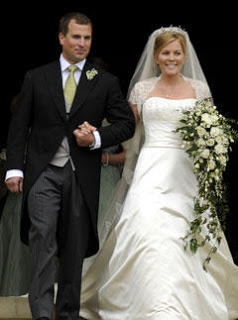 The Queen's eldest grandchild, Peter Phillips, married Canadian Autumn Kelly at St. George's Chapel, Windsor Castle, on May 17, 2008. The strapless dress was certainly au courant with its lace shrug, or bolero, if you wish. It was designed by Sassi Holford, one of the leading bridal gown providers in Britain. The tiara worn by Autumn was the "something borrowed" -- from Anne, Princess Royal, Autumn's new mother-in-law.
The Queen's eldest grandchild, Peter Phillips, married Canadian Autumn Kelly at St. George's Chapel, Windsor Castle, on May 17, 2008. The strapless dress was certainly au courant with its lace shrug, or bolero, if you wish. It was designed by Sassi Holford, one of the leading bridal gown providers in Britain. The tiara worn by Autumn was the "something borrowed" -- from Anne, Princess Royal, Autumn's new mother-in-law.The Queen's first great grandchild was born to Autumn and Peter on December 29, 2010, named Savannah.
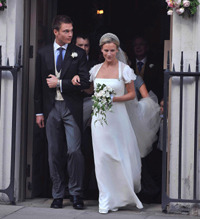 Lady Rose Windsor, daughter of the Duke of Gloucester (cousin of Queen Elizabeth II), was married to George Gilman, on July 19, 2008 at the Queen's Chapel, St. James Palace. The gown is lovely and the tiara one loaned from the royal collection, but finding the name of the dress designer was impossible -- all the press reports focused on what Kate Middleton was wearing.
Lady Rose Windsor, daughter of the Duke of Gloucester (cousin of Queen Elizabeth II), was married to George Gilman, on July 19, 2008 at the Queen's Chapel, St. James Palace. The gown is lovely and the tiara one loaned from the royal collection, but finding the name of the dress designer was impossible -- all the press reports focused on what Kate Middleton was wearing.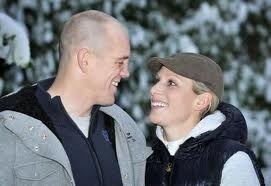 In addition to the wedding of Kate and Prince William on April 29, there will be another royal wedding this year in the U.K. Zara Phillips, daughter of Anne, Princess Royal, is engaged to rugby star Mike Tindall. Their wedding will probably be in Edinburgh on July 3o. Best wishes, Zara.
In addition to the wedding of Kate and Prince William on April 29, there will be another royal wedding this year in the U.K. Zara Phillips, daughter of Anne, Princess Royal, is engaged to rugby star Mike Tindall. Their wedding will probably be in Edinburgh on July 3o. Best wishes, Zara.
Published on February 13, 2011 02:00
February 12, 2011
Royal Wedding Gowns
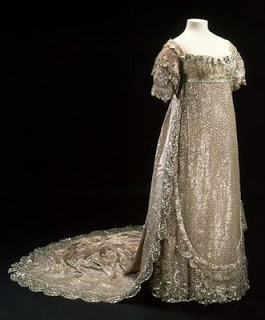 As I write this, there is no word on the designer Kate Middleton has chosen to create her wedding gown, though I have heard many breathless accounts of who is and who is not in the running. So let's indulge our royal wedding mania for a while by looking at some of the gowns worn in the past.
As I write this, there is no word on the designer Kate Middleton has chosen to create her wedding gown, though I have heard many breathless accounts of who is and who is not in the running. So let's indulge our royal wedding mania for a while by looking at some of the gowns worn in the past.At the left is the dress worn by Princess Charlotte of Wales at her May 2, 1816, wedding to Prince Leopold of Saxe-Coburg, as exhibited in the Museum of London here.
The Lady's magazine of May, 1816, described the gown: White silk net embroidered in silver strip with a spotted ground and borders. The wedding dress, composed of a most magnificent silver lama on net, over a rich silver tissue slip, with a superb border of silver lama embroidery at the bottom, forming shells and bouquets above the border; a most elegant fullness tastefully designed, in festoons of rich silver lama, and finished with a very brilliant rollio of lama; the body and sleeves to correspond, trimmed with a most beautiful point Brussels lace, in a peculiar elegant style.
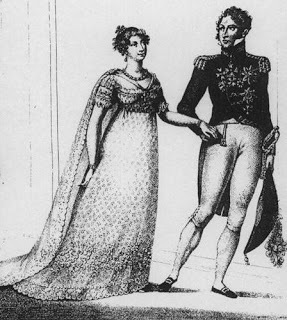 The manteau of rich silver tissue lined with white satin, trimmed round with a most superb silver lama border, in shells to correspond with the dress, and fastened in front with a most brilliant and costly ornament of diamonds. The whole dress surpassed all conception in the brilliancy and richness of its effects. Head dress, a wreath of rose buds and leaves, composed of the most superb brilliants." At right, an engraving of Charlotte and Leopold at their wedding in Carlton House.
The manteau of rich silver tissue lined with white satin, trimmed round with a most superb silver lama border, in shells to correspond with the dress, and fastened in front with a most brilliant and costly ornament of diamonds. The whole dress surpassed all conception in the brilliancy and richness of its effects. Head dress, a wreath of rose buds and leaves, composed of the most superb brilliants." At right, an engraving of Charlotte and Leopold at their wedding in Carlton House. 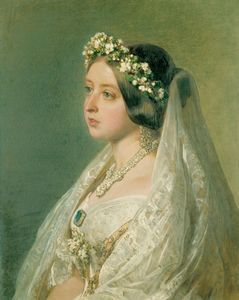 The portrait of Queen Victoria, at left, is by Winterhalter. It shows a rather wistful young bride at the time of her wedding to Prince Albert of Saxe-Coburg (nephew of the above-mentioned Leopold) on February 10, 1840 in the Chapel Royal of St. James Palace.It was this gown and veil that supposedly has inspired generations of brides ever since to wear white for their ceremonies, though many brides had previously dressed in fashionable white as well as in a variety of other hues.
The portrait of Queen Victoria, at left, is by Winterhalter. It shows a rather wistful young bride at the time of her wedding to Prince Albert of Saxe-Coburg (nephew of the above-mentioned Leopold) on February 10, 1840 in the Chapel Royal of St. James Palace.It was this gown and veil that supposedly has inspired generations of brides ever since to wear white for their ceremonies, though many brides had previously dressed in fashionable white as well as in a variety of other hues. 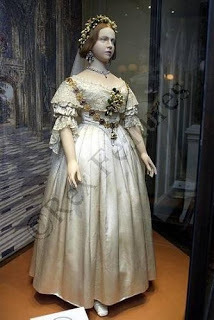
At right, an image of Queen Victoria's dress on a mannequin in the collection of Kensington Palace.
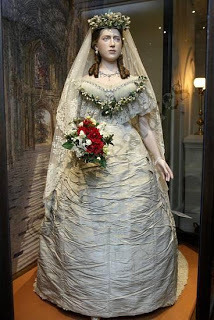
Left, the wedding gown of Alexandra of Denmark, who married Victoria's son, eventually King Edward VII, on March 10, 1863 in St. George's Chapel at Windsor Castle. She was Princess of Wales for almost forty years before becoming Queen in 1901. After her husband's death in 1910, she was known as the Queen Mother until she died in 1925.
Like Charlotte's mother, Caroline, Princess of Wales, and like the first wife of the present Prince of Wales, Diana (see below), Alexandra had to endure the infidelity of her husband. But unlike the other two, she stuck with him to the end. We've all heard the possibly-apocryphal story about how Alexandra invited one of his mistresses, Alice Keppel, to comfort Edward VII on his deathbed.
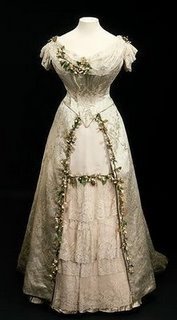 Princess Mary of Teck wed Prince George, Duke of York on 6 July, 1893 in the Chapel Royal of St. James Palace. She had been engaged to Prince Albert Victor, eldest son of the Prince of Wales in 1891, but Albert Victor died in the great influenza epidemic of 1891-92. Mary and George fell in love and were married with the approval of Queen Victoria as well as Edward and Alexandra, Prince and Princess of Wales. George succeeded his father as George V in 1910. Queen Mary, who was a godchild of Queen Victoria, had five sons and one daughter. Her eldest son, known to all as David, was more than a disappointment. After inheriting the throne as Eward VIII in 1936, he abdicated less than a year later to marry Wallis Simpson.
Princess Mary of Teck wed Prince George, Duke of York on 6 July, 1893 in the Chapel Royal of St. James Palace. She had been engaged to Prince Albert Victor, eldest son of the Prince of Wales in 1891, but Albert Victor died in the great influenza epidemic of 1891-92. Mary and George fell in love and were married with the approval of Queen Victoria as well as Edward and Alexandra, Prince and Princess of Wales. George succeeded his father as George V in 1910. Queen Mary, who was a godchild of Queen Victoria, had five sons and one daughter. Her eldest son, known to all as David, was more than a disappointment. After inheriting the throne as Eward VIII in 1936, he abdicated less than a year later to marry Wallis Simpson.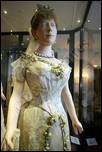 Queen Mary, after her husband's death chose to be addressed as Her Majesty, Queen Mary, rather than as Queen Mother. She was very supportive of her second son who became King George VI after his brother's departure from the throne. According to several sources, she was the first dowager queen of Great Britain who ever attended the coronation ceremony of her husband's successor.
Queen Mary, after her husband's death chose to be addressed as Her Majesty, Queen Mary, rather than as Queen Mother. She was very supportive of her second son who became King George VI after his brother's departure from the throne. According to several sources, she was the first dowager queen of Great Britain who ever attended the coronation ceremony of her husband's successor. 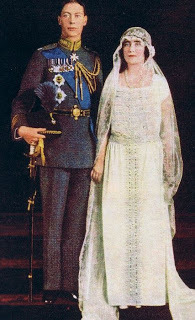 As Duke of York, the second son of George V and Mary grew up in the shadow of his dashing older brother. He married Lady Elizabeth Bowes-Lyon on 26 April 1923 in Westminster Abbey. At the time of the wedding, it was not expected that "Bertie" would take the throne. Lady Elizabeth's gown, perhaps for that reason, was not as elaborate as some of her predecessors. It was certainly in the style of the day, a rather loose gown, slightly less than floor length. Below is the dress on a mannequin in a Kensington Palace exhibition of several years ago, along with a detail of the veil and bodice.
As Duke of York, the second son of George V and Mary grew up in the shadow of his dashing older brother. He married Lady Elizabeth Bowes-Lyon on 26 April 1923 in Westminster Abbey. At the time of the wedding, it was not expected that "Bertie" would take the throne. Lady Elizabeth's gown, perhaps for that reason, was not as elaborate as some of her predecessors. It was certainly in the style of the day, a rather loose gown, slightly less than floor length. Below is the dress on a mannequin in a Kensington Palace exhibition of several years ago, along with a detail of the veil and bodice.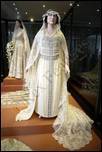
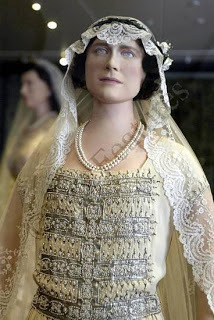
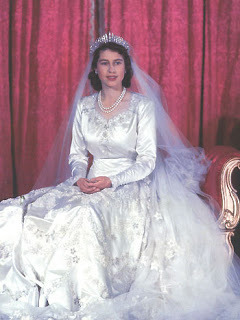 On 20 November, 1947, Princess Elizabeth (later Queen Elizabeth II) married Prince Philip of Greece (later Duke of Edinburgh) in Westminster Abbey. The designer was Norman Hartnell and the fabric is silk spun at Lullingstone Castle in Kent. She wore a diamond and pearl tiara and a filmy veil. The long train was decorated with traditional symbols, such as Tudor roses and wheat. All the details of the royal romance, the wedding, the gown and the ceremony were eagerly read around the world. It is said the happy event was like a tonic to the war-weary Britons still enduring shortages of goods and rationing.
On 20 November, 1947, Princess Elizabeth (later Queen Elizabeth II) married Prince Philip of Greece (later Duke of Edinburgh) in Westminster Abbey. The designer was Norman Hartnell and the fabric is silk spun at Lullingstone Castle in Kent. She wore a diamond and pearl tiara and a filmy veil. The long train was decorated with traditional symbols, such as Tudor roses and wheat. All the details of the royal romance, the wedding, the gown and the ceremony were eagerly read around the world. It is said the happy event was like a tonic to the war-weary Britons still enduring shortages of goods and rationing.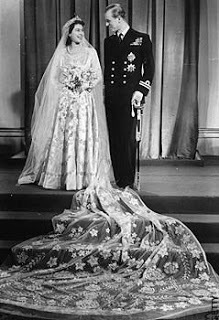
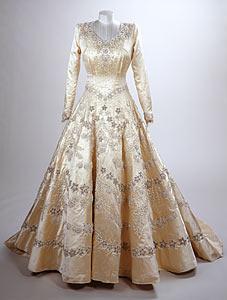 The Gown on a mannequin
The Gown on a mannequin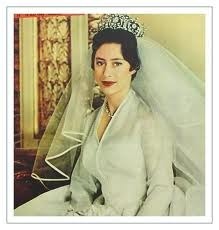
Princess Margaret, second daughter of King George VI, married Antony Armstrong-Jones (later Earl of Snowdon) on May 6, 1960, at Westminster Abbey. Television cameras covered the event and the broadcast was seen worldwide. Like her sister, Margaret chose Norman Hartnell to design her bridal gown.The couple had two children: David, Viscount Linley in 1961 and Lady Sarah Armstrong-Jones in 1964. The Snowdons were divorced in 1978 and Princess Margaret died in 2002.
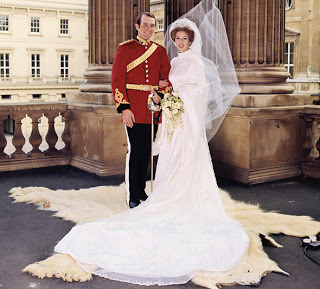 14 November 1973 - Anne, Princess Royal, married Captain Mark Phillips in Westminster Abbey. Born in 1950, she is Queen Elizabeth II's only daughter. Anne and Phillips have two children, Peter Phillips born in 1977 and Zara Phillips born in 1981. After divorcing Phillips in 1992, Anne married Timothy Laurence, in Scotland on December 12, 1992.
14 November 1973 - Anne, Princess Royal, married Captain Mark Phillips in Westminster Abbey. Born in 1950, she is Queen Elizabeth II's only daughter. Anne and Phillips have two children, Peter Phillips born in 1977 and Zara Phillips born in 1981. After divorcing Phillips in 1992, Anne married Timothy Laurence, in Scotland on December 12, 1992.
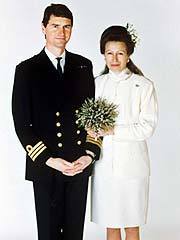
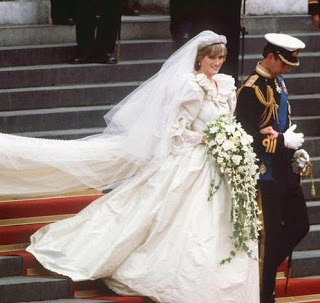 On 29 July 1981, Lady Diana Spencer and Charles, Prince of Wales, were married in St Paul's Cathedral. Her dress was controversial -- and still is. The designers, David and Elizabeth Emmanuel, immediately shot to the top echelon of British fashion. Like many of Diana's fashions, the gown (or a replica) travels around the world for popular exhibition.
On 29 July 1981, Lady Diana Spencer and Charles, Prince of Wales, were married in St Paul's Cathedral. Her dress was controversial -- and still is. The designers, David and Elizabeth Emmanuel, immediately shot to the top echelon of British fashion. Like many of Diana's fashions, the gown (or a replica) travels around the world for popular exhibition.Charles and Diana had two sons, Prince William, born in 1982, and Prince Harry, born in 1984.
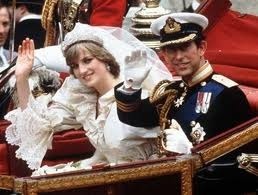
Charles and Diana separated in the late 1980s, the Prince living in Highgrove and the Princess at Kensington Palace. Formal separation came in 1992 and the marriage of Charles and Diana ended in divorce on 28 August 1996. On 31 August 1997, a year after the Prince and Princess divorced, Diana died in a car crash in Paris.
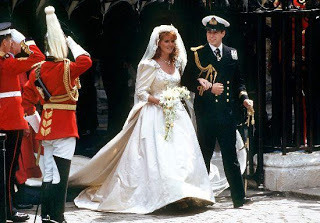 Sarah Ferguson and Prince Andrew, the Duke of York, married at Westminster Abbey on 23 July 1986. The Duke and Duchess of York had two children during their marriage: Princess Beatrice of York (born 1988) and Princess Eugenie of York (born 1990). They separated in 1992 and divorced in 1996, though they are often together for vacations and family events.
Sarah Ferguson and Prince Andrew, the Duke of York, married at Westminster Abbey on 23 July 1986. The Duke and Duchess of York had two children during their marriage: Princess Beatrice of York (born 1988) and Princess Eugenie of York (born 1990). They separated in 1992 and divorced in 1996, though they are often together for vacations and family events. 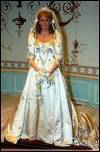
Of all the gowns shown above, I think I like Sarah's best, as designed by Lindka Cierach. It is beautiful, flattering to her and has no gimmicks. Princess Elizabeth's was lovely too, but I like Sarah's veil better. All in all this one is the winner in the gown category, if perhaps not in the list of "most suitable royal brides."
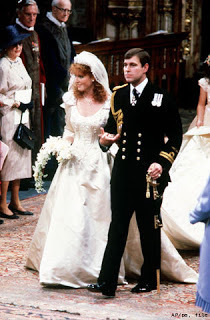
If like us, you can't get enough of this wedding stuff, here is a wonderful exhibition from the royal collection you will enjoy. And more to c0me here.
Published on February 12, 2011 02:00
Kristine Hughes's Blog
- Kristine Hughes's profile
- 6 followers
Kristine Hughes isn't a Goodreads Author
(yet),
but they
do have a blog,
so here are some recent posts imported from
their feed.



